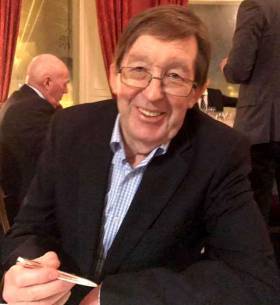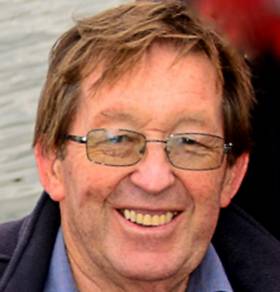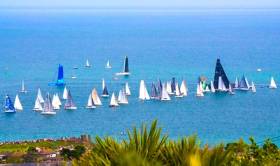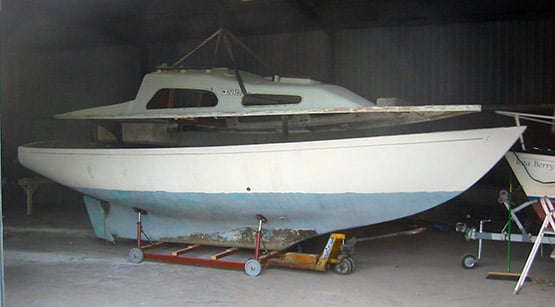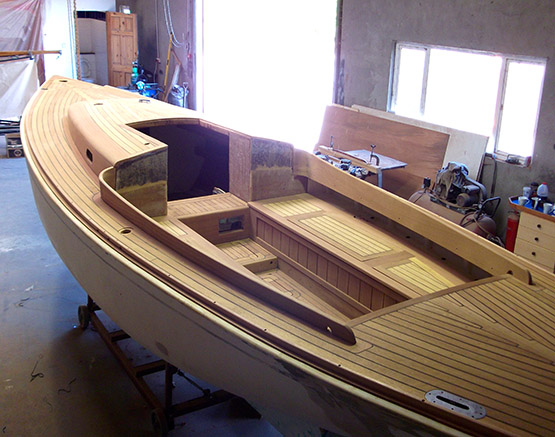Displaying items by tag: W M Nixon
Wicklow Sailing Club Inspires Irish Sailing as it Becomes Mitsubishi Motors Club of the Year 2017
Irish sailing’s informal inter-club competition has named a “Club of the Year” annually since 1979, and since 1986 the title’s steadfast sponsorship support from Mitsubishi Motors has made it an integral part of the national sailing scene. Yet it has proven to be something which does not lend itself easily to imitations elsewhere. Other sailing countries have tried to establish versions of it. But somehow it has never worked as effectively as it has in Ireland, where the size of the country, the number, size and variety of our clubs, the sense of community within our sailing, and our very long history of having clubs in some form at the heart of our sport - all these factors contribute to making this special competition viable in Ireland.
These elements combine to contribute to a continually developing awareness of how a successful club must play a key role in its local community as well as making a contribution of significance to the national sailing programme, while at the same time encouraging new boat talent and interest at every level. At the same time, club officers and committee have to be acutely aware that they are functioning in a constantly changing socio-economic environment in which the “business model” of a sailing club has to be continually monitored, regularly modified, and sometimes radically changed if it is to continue operating successfully. W M Nixon tries to capture the mood of Wicklow Sailing Club as it takes on the mantle of “Mitsubishi Motors Sailing Club of the Year 2017” with the new sailing season getting into its stride.
There’s something about Wicklow Sailing Club that makes everyone lighten up as they step through the front door of its friendly little clubhouse. It becomes a characterful little place where people of many backgrounds from a wide swathe of the Garden County and beyond express their shared enthusiasm for boats and people and those who sail them – and more particularly, for those who would like to sail them, but need encouragement to enter what is a strange world for people from a completely different landbound background.
For it was Wicklow Sailing Club’s energetic and imaginative ways of encouraging their own youngsters afloat, together with others from a non-sailing background, which contributed greatly to its becoming the Mitsubishi Motors “Sailing Club of the Year 2017” at a very relaxed summer’s evening ceremony this week.
Of course the club’s continued and determined staging of the biennial 704-mile Volvo Round Ireland Race, which attracted a record and very international entry of 63 boats with records tumbling every which way in 2016, was an important consideration in the winning of the award.
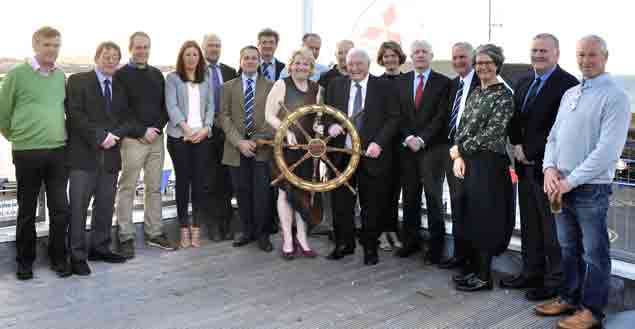 Wicklow SC’s committee and special volunteers on the podium with (left to right) Fergus Somers (committee), W M Nixon of adjudicators, Mark Redmond (Rear Commodore, Dinghies), Joanne Logan (Accounts Officer), Dave Ballesty (Juniors), Michael Martin (Rear Commodore, House), Charlie Kavanagh (Committee), Commodore Denise Cummins, Kyran O’Grady (Hon. Treas.), Eugene Lynch (Rear Commodore Cruisers), Frank Keane of FKH, owners of Mitsubishi Motors, Roisin Hennessy (Vice Commodore), Billy Riordan (CEO of FKH), Peter Shearer (Hon. Sec.), Angela Higgins (Committee & PR), Jack Roy (President Irish Sailing Association), and Hal Fitzgerald (WSC Commodore 2015-2016). Photo Roseita Burke
Wicklow SC’s committee and special volunteers on the podium with (left to right) Fergus Somers (committee), W M Nixon of adjudicators, Mark Redmond (Rear Commodore, Dinghies), Joanne Logan (Accounts Officer), Dave Ballesty (Juniors), Michael Martin (Rear Commodore, House), Charlie Kavanagh (Committee), Commodore Denise Cummins, Kyran O’Grady (Hon. Treas.), Eugene Lynch (Rear Commodore Cruisers), Frank Keane of FKH, owners of Mitsubishi Motors, Roisin Hennessy (Vice Commodore), Billy Riordan (CEO of FKH), Peter Shearer (Hon. Sec.), Angela Higgins (Committee & PR), Jack Roy (President Irish Sailing Association), and Hal Fitzgerald (WSC Commodore 2015-2016). Photo Roseita Burke
But those involved in the adjudication quietly kept tabs on Wicklow SC’s levels of more ordinary activity after the big event had been tidied away at the end of June. Its successful staging had seemed to involve just about every member of the club in some voluntary function, led by Race Organiser Theo Phelan and his Chairman Peter Shearer, so you might have expected Wicklow sailing to relax for a while.
Not a bit of it. Junior sailing and introductory courses under the direction of the likes of Dave Ballesty and Mark Redmond were up and running again within days, the local dinghy racing and cruiser-racing programme was back in action with Jason Moran scoring tops in the latter in Hydrogin, and on the national and international front, Wicklow’s own Barry Byrne – now Commandant Barry Byrne – skippered the Defence Forces’ J/109 Joker 2 to a convincing victory in the new Beaufort Cup, the inter-military and maritime agencies offshore sailing competition which, in its inaugural year in 2016 in Cork, attracted an international entry of 32 boats and crews.
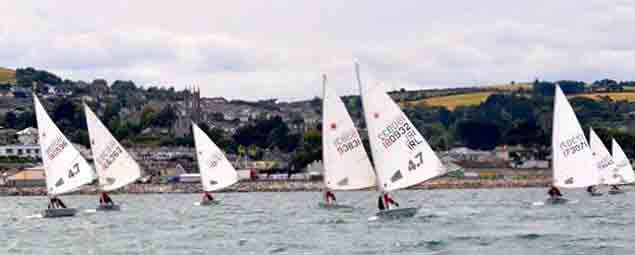 Club activity resumes – Laser racing in Wicklow Bay
Club activity resumes – Laser racing in Wicklow Bay
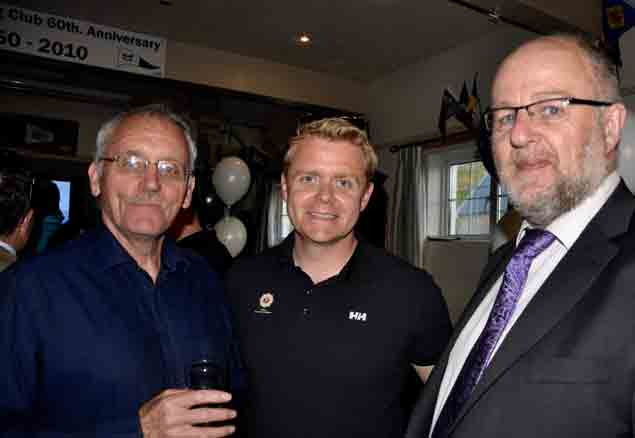 International success. Commandant Barry Byrne (centre), first skipper to win the new Beaufort Cup in command of the Defence Forces J/109 Joker Two, at the “Club of the Year” reception with his father Shea (left) and Dave Ballesty. Photo Angela Higgins
International success. Commandant Barry Byrne (centre), first skipper to win the new Beaufort Cup in command of the Defence Forces J/109 Joker Two, at the “Club of the Year” reception with his father Shea (left) and Dave Ballesty. Photo Angela Higgins
Such achievements, and those of other renowned Wicklow offshore sailors such as Brian Flahive, Simon Greenwood, Charlie Kavanagh and Alan Rountree, speak of a well-balanced club whose friendly premises - in the very maritime setting down at the beginning of the East Pier clustered close with the Wicklow lifeboat HQ, they’re in a sort of citadel of the sea – are popular for hosting events of local organisations which may have no connection with the sea whatever.
It was this particular sense of welcome which was most evident for those arriving for this week’s presentation, with Wicklow Sailing Club represented by new Commodore Denise Cummins and also by 2016 Commodore Hal Fitzgerald, while WSC’s national and international partners were there with Jack Roy, President of the Irish Sailing Association, and leading ISA Board members including Brian Craig of Dun Laoghaire and Sarah Byrne of Greystones as well as CEO Harry Hermon and members of his staff who deal directly with Wicklow, notably Eastern Region Development Officer Sarah-Louise Rossiter.
The leading international organisation with which Wicklow is most closely involved is of course the Royal Ocean Racing Club who provide massive support for the Round Ireland race. Although current Commodore Michael Boyd – a round Ireland winner in 1996 and top Irish boat in 2016 – couldn’t be there personally, he ensured he was very ably represented by his brother Paddy Boyd. Paddy is a veteran of several Round Irelands but is also, as it emerged on the night, a veteran of a certain event which made Wicklow Sailing Club the very first Sailing Club of the Year way back in 1979, in the brief pre-Mitsubishi Motors years - more of that later.
 Spanning the generations. At the award of the Mitsubishi Motors “Sailing Club of the Year 2017” trophy to Wicklow Sailing Club were (back row, left to right) Cillian Ballesty, Robert Bell King, Carl Somers, Kieran Fitzgerald and Ryan Fitzgerald, (middle row) W M Nixon, Billy Riordan (CEO Frank Keane Holdings), Jack Roy (President Irish Sailing Association), Frank Keane (Chairman FKH, owners of Mitsubishi Motors Ireland), Denise Cummins (Commodore, Wicklow SC (2017-2018), Hal Fitzgerald (Commodore WSC 2015-2016), and Gerard Rice (MD, Mitsubishi Motors) (front row) Jack Cummins and Hal Og Fitzgerald. Photo: Angela Higgins
Spanning the generations. At the award of the Mitsubishi Motors “Sailing Club of the Year 2017” trophy to Wicklow Sailing Club were (back row, left to right) Cillian Ballesty, Robert Bell King, Carl Somers, Kieran Fitzgerald and Ryan Fitzgerald, (middle row) W M Nixon, Billy Riordan (CEO Frank Keane Holdings), Jack Roy (President Irish Sailing Association), Frank Keane (Chairman FKH, owners of Mitsubishi Motors Ireland), Denise Cummins (Commodore, Wicklow SC (2017-2018), Hal Fitzgerald (Commodore WSC 2015-2016), and Gerard Rice (MD, Mitsubishi Motors) (front row) Jack Cummins and Hal Og Fitzgerald. Photo: Angela Higgins
Today, the Mitsubishi Motors team are still led by Chairman Frank Keane, who has been involved since 1986, and Frank and his son Brian and their group arrived into WSC to find themselves being welcomed not just by the great and the good in national and international sailing, but also by leaders of other Wicklow marine, business and administrative bodies whose presence very effectively demonstrated how WSC is at the nexus of the little commercial and recreational port’s interaction with the sea.
Mitsubishi Motors involvement with sailing continues to have a decidedly personal element, as Billy Riordan, CEO of Frank Keane Holdings, the parent company, is both a keen SB20 sailor in Dublin Bay and beyond, and an Optimist dad at major competitions all over the country. His group included Mitsubishi Motors MD Gerard Rice and their Wicklow agents, Dale Moran and Gavin Moran of the Morans of Avoca group, something which meant they were inevitably described in the course of the evening as being the Mitsubishi Motors agents for Ballykissangel – that’s showbusiness for you.
Keeping us all on the right track was Roseita Burke, Mitsubishi Motors Marketing & PR Manager, who is now renowned in sailing for getting good weather for this annual event. It’s usually staged early in the summer just as the “proper” season is getting into gear, and the winning clubs get into the spirit of it all by dressing overall as though it’s Regatta Day. But it all wouldn’t quite work unless we’d a sunny evening, and despite the week’s decidedly mixed weather, once again Roseita worked her magic, and the sun shone.
But if all this organizational effort goes unrecorded it’s soon forgotten, and an ace photographer is needed, so when key WSC administrator Peter Shearer - a former Commodore and Round Ireland Chairman who has now taken up the reins as Honorary Secretary - assured us that in Angela Higgins the club had its own amateur photographer who could produce work of professional standard and was very good at getting the right people into the right groups, it all seemed too good to be true. But as the results show, it was true, Angela was brilliant, and her huge contribution to the success of the evening speaks volumes for the voluntary spirit of Wicklow SC.
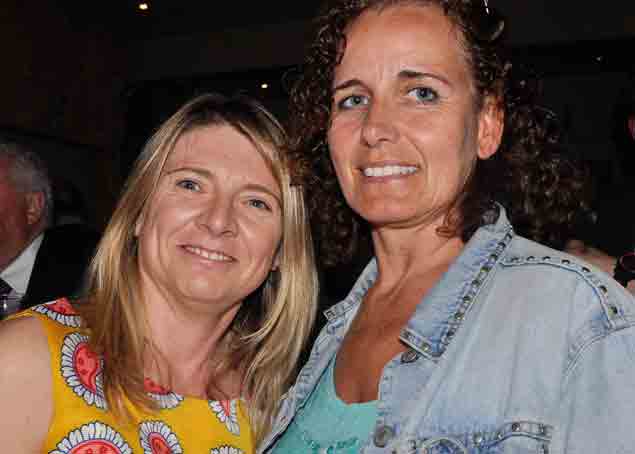 Kenya Lynch of Wicklow SC (left) and Sarah Byrne of Greystones SC, who is also a Director of the Irish Sailing Association. Photo: Angela Higgins
Kenya Lynch of Wicklow SC (left) and Sarah Byrne of Greystones SC, who is also a Director of the Irish Sailing Association. Photo: Angela Higgins
Inevitably in such a surge of life there were those who couldn’t be there, and ISORA Chairman Peter Ryan, whose organization had already run its first race of the year from Dun Laoghaire to Wicklow on April 22nd, and is personally a great fan of what Wicklow does for offshore racing, was absent with the sad death of his mother - our thoughts were with him. And our thoughts were also very much with WSC President and very long-serving and active member Gerry Nolan, who was over the moon about his baby being Club of the Year, but he’d been kept in dock in hospital under doctor’s orders. So good wishes were conveyed directly to him through his wife Angela, who was there for him at the party, and it was quipped that, being Gerry, he’d probably re-organised the hospital’s CCTV cameras in order to follow events in WSC.
It was such a remarkable gathering of so many viewpoints from within Wicklow and beyond that it was an ideal opportunity for new Irish sailing Association President Jack Roy to tell us, in his speech, of his hopes and plans for Irish sailing. This is a President for us all. He’s not just a President for the top international medal-achieving sailors, but a President for whom the interests of the ordinary club sailor or indeed anyone who’s interested in sailing - whether they race a bit or limit their activities to cruising or simply day sailing – merit close attention and support.
His parents were founder members of Greystones Sailing Club, and the President reckons the smaller clubs such as big-hearted Wicklow (it has about 160 members with all categories included) are the true life blood of sailing, “the core strength of our sport around the coast”.
During his Presidency he intends to visit absolutely every club in Ireland , which knowing Jack means in several cases it will be many times. His exuberant enthusiasm, shown through his many race officer duties and personal Squib sailing and cruising with his Halberg Rassy cutter, is an inspiration to his members, and it enables him to voice strong opinions on re-shaping sailing for its own good.
Despite being a commited boat owner himself, he is more than ready to welcome those who just want to taste sailing without financial commitment, and he particularly commended Wicklow’s club ownership of sailing dinghies which are made readily available for public use.
Jack Roy had many other fresh and invigorating ideas, but as we’ll be shortly doing a full interview with him for a future Sailing on Saturday, we’ll give those views and others a proper airing in due course. Meanwhile, this week he brilliantly conveyed the goodwill of the entire Irish sailing community to Wicklow SC in their success, and the gratitude of all involved to Mitsubishi Motors for their continuing support of an informal but important competition which helps us all to understand and support Ireland’s sailing clubs in a positive way.
On behalf of Mitsubishi Motors, Billy Riordan, CEO of Frank Keane holdings, spoke particularly if his own enthusiasm for the way in which the “Club of the Year” competition encourages clubs to re-think their relationship with the larger community around them. Sailing clubs are a vital interconnector between sea and land, and their unique position enables them to provide lines of communication which are of benefit to everyone, while the use of their premises for non-maritime events has contributed greatly to mutual understanding.
But as mentioned at the beginning, simply being in Wicklow Sailing Club makes everyone lighten up, and Billy went cheerfully off script to talk of his own experiences in taking part in the Round Ireland Race. This is a rite of passage for every Irish sailor, and for most of us - as in Billy’s case - the memories can be of great amusement as much as they are of more serious stuff dealing with the challenges of racing on the Atlantic Ocean.
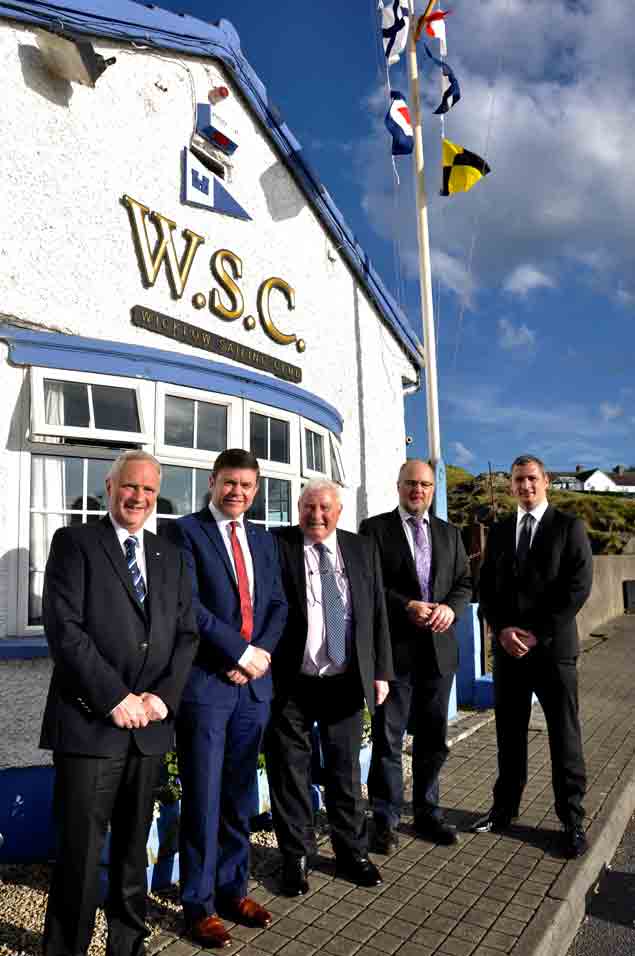 It was like regatta time....Wicklow SC Hon. Sec. Peter Shearer (left) with Gerard Rice (MD Mitsubishi Motors), Frank Keane (Chairman, FKH, Dave Ballesty of Wicklow SC, and Brian Keane of FKH. Photo Angela Higgin
It was like regatta time....Wicklow SC Hon. Sec. Peter Shearer (left) with Gerard Rice (MD Mitsubishi Motors), Frank Keane (Chairman, FKH, Dave Ballesty of Wicklow SC, and Brian Keane of FKH. Photo Angela Higgin
In response to all this, Wicklow Sailing Club Commodore Denise Cummins made a speech which so perfectly encapsulated the spirit of the club and the mood of the evening that it’s only right and proper to reproduce its key messages:
“It is my pleasure to welcome you all to Wicklow Sailing Club tonight. We are delighted to see so many friends from near and far joining us on this special evening. In particular we welcome the Club of the Year adjudicators, and are honoured to have Frank Keane and Billy Riordan and their team from Mitsubishi Motors.
We welcome Jack Roy our new ISA President, and also Paddy Boyd – well known to many of us – representing his brother Michael, Commodore of our very good friends at the Royal Ocean racing Club.
We welcome too the representatives from our local community, who give us as a club so much support. Representatives from the RNLI, from Wicklow Chamber & local businesses, from Sailfest, from the County Council, from local Sports Partnership, from nearby sailing clubs, from other water-sports clubs, and so on - it’s great that you are all here.
Our club President, Gerry Nolan, was really looking forward to this evening’s reception, but unfortunately as you have heard he is unable to be here. We are delighted to see that Angela could make it here tonight. We wish him well and look forward to seeing him again as soon as possible. But now that I think of it, he has remote access to our security cameras so I wouldn’t be a bit surprised if he was keeping an eye on me right now!!
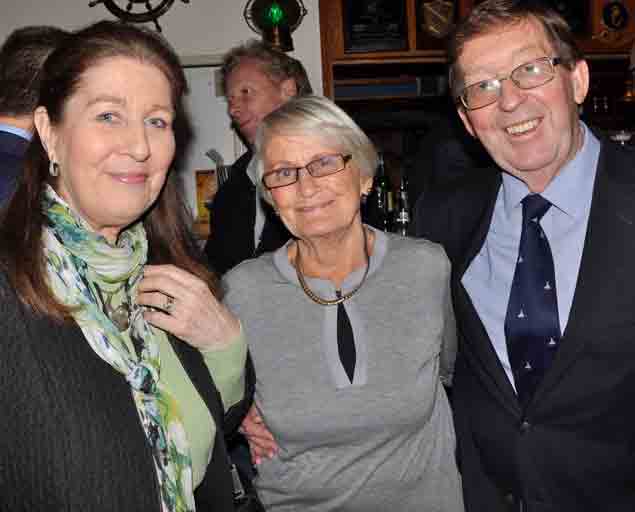 Georgina Campbell, Angela Nolan and Afloat.ie’s W M Nixon Photo Angela Higgins
Georgina Campbell, Angela Nolan and Afloat.ie’s W M Nixon Photo Angela Higgins
I have been a member of this sailing club for a number years now, not that long, but I certainly wasn’t here when WSC was first awarded the Club of the Year back in 1979, the first club to receive the award. However, we do have a photograph of the presentation of the award in 1979, a photograph which includes a bearded & only slightly younger-looking Winkie Nixon!
As Commodore of WSC, I would like to thank Mitsubishi Motors for this award, the Mitsubishi Sailing Club of the Year 2017. We are both delighted & very proud to accept this wonderful award. It will be displayed with great pride of place in our club.
I would also like to thank Mitsubishi Motors for continuing to sponsor this award and we acknowledge their contribution, reflected in the ethos in that company, not just to us as a club, but indeed to the local community. It underlines the recognition of the hard work of volunteer club members and the community. Our club is firmly based in the community and we receive a lot of support from the local community here in Wicklow.
The ethos and spirit of the club has evolved over many years and on my watch I want to ensure that this continues on into the future.
Last year’s Committee Boat, as we might call our club administration, started with an able crew of many helpers. This honour of running Wicklow Sailing Club is now bestowed on our 2017 group.
It is easy to take over when a ship has been running a good course, and sailed with skill and good judgment. A special thank you to Peter Shearer, Gerry Nolan and Kevin Desmond for working hard as our anchors, while Hal Fitzgerald was on helm as Commodore, and provided a steady hand on the tiller .
Theo Phelan as Race Organiser of the Round Ireland is our kite, our spinnaker, always on a run leading us ahead. Our mainsail handlers and trimmers - Dave Ballesty, Roisin Henessy and Mark Redmond - have organised and trained many sailors for years, and last year in particular the dinghy section was one of high achievement - they are the power house of sailing from the root up.
Brian Malone and Eugene Lynch are our headsail and foredeck men, converting the juniors and turning them into Cruising Adult Sailors.
Angela Higgins and Fergus Sommer are our telltales, helping us to pick up the change in wind and ensure we are in tune with our community, environment and surroundings.
Kyran O’Grady is our mast and boom, supporting every facet of the club while ensuring the sheets and halliards don’t get tangled, yet in addition he is the glue which holds the club together.
David Ryan is our bow-sprit, always looking at least eight feet ahead, always looking outward and forward. Not all clubs have this vision, let alone a visionary like Farmer Ryan with his practicality combined his direction and passion.
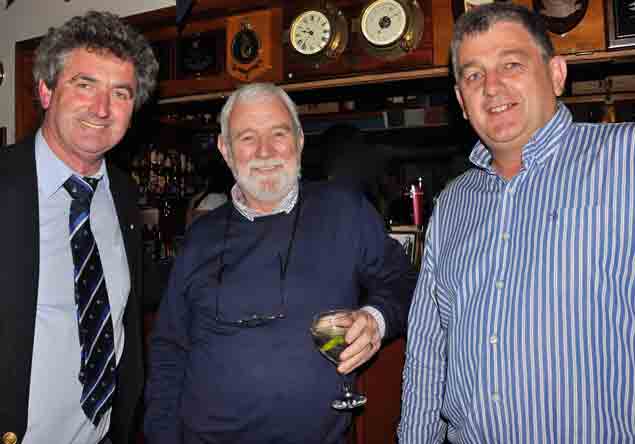 The men who make things happen. Leading offshore sailor and committee member Charlie Kavanagh (left) with Round Ireland Race organiser Theo Phelan and David “Farmer” Ryan Photo: Angela Higgins
The men who make things happen. Leading offshore sailor and committee member Charlie Kavanagh (left) with Round Ireland Race organiser Theo Phelan and David “Farmer” Ryan Photo: Angela Higgins
Yet the boat whch is the club cannot sail without the wind, and our wind is our volunteers and our sailors, all our members who keep us moving forward, pushing us, carry us through the course, across the line to every finish.
Thank you to our friends in the local community who give us such great support. It is wonderful to have an opportunity to say a big thank you to everyone, who turn out week after week throughout the year, and who make the club the great place it is.
It is very fitting that the award is made during this week, which is National Volunteer Week. This deserves celebration. So while the club is all about sailing and fostering the community and getting people on the water, ultimately the club is also about having fun. Tonight is one of those many fun occasions. So now you know what you have to do for the remainder of this evening, which I hope you will enjoy.”
 Celebrating their club’s success as Mitsubishi Motors “Sailing Club of the Year 2017” are WSC members (left to right) Paul Sinnott, Paul Carr, Tony Gillespie, Kevin Desmond (Trustee, Wicklow SC) and Derek Stuart. Photo: Angela Higgins
Celebrating their club’s success as Mitsubishi Motors “Sailing Club of the Year 2017” are WSC members (left to right) Paul Sinnott, Paul Carr, Tony Gillespie, Kevin Desmond (Trustee, Wicklow SC) and Derek Stuart. Photo: Angela Higgins
Which they most certainly did. And during it, Paddy Boyd reminisced about Wicklow’s first win back in 1979, when they got the trophy for organizing a sailing rally open to everyone. He was one of the few present this week who had taken part all of 38 years ago, and it showed Wicklow SC what it could do if it spread its wings. It certainly gave Wicklow the Great Idea. The following year in 1980, the Round Ireland Race was inaugurated. The rest you know.
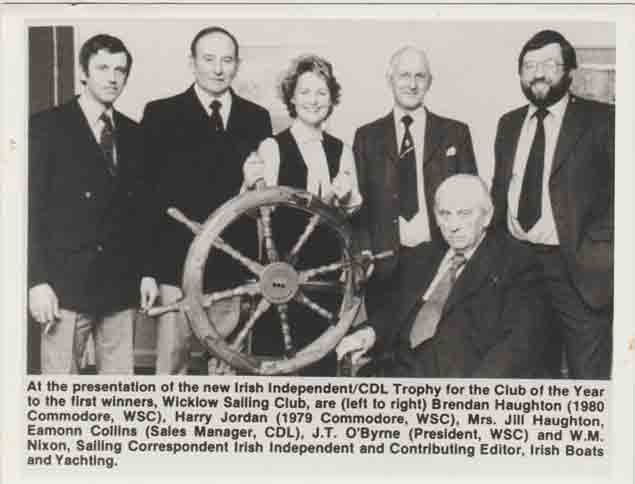 That was then – Wicklow SC become the first “Sailing Club of the Year” in 1979
That was then – Wicklow SC become the first “Sailing Club of the Year” in 1979
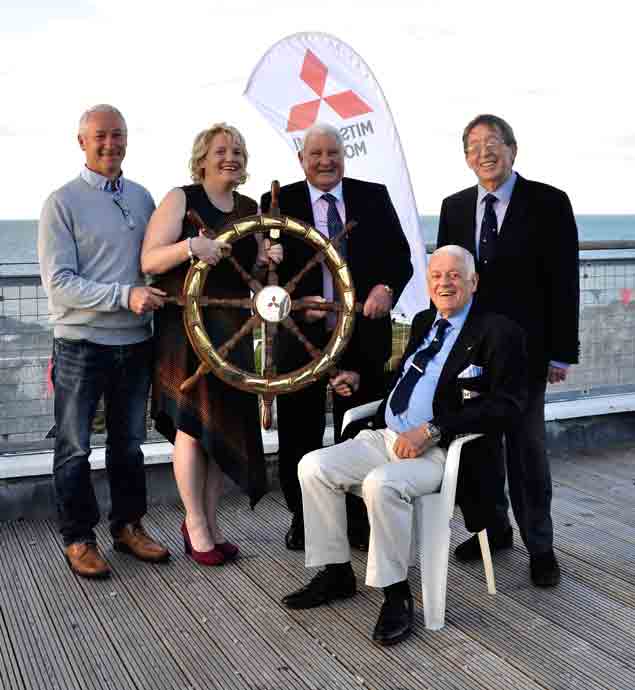 This is now. Wicklow SC are the Mitsubishi Motors “Sailing Club of the Year 2017” with (left to right) Hal Fitzgerald (WSC Commodore 2015-2016), WSC Commodore Denise Cummins, Frank Keane of FKH, and on the right are two from the original photo – Brendan Haughton (seated, Commodore WSC 1980) and W M Nixon. Photo Angela Higgins
This is now. Wicklow SC are the Mitsubishi Motors “Sailing Club of the Year 2017” with (left to right) Hal Fitzgerald (WSC Commodore 2015-2016), WSC Commodore Denise Cummins, Frank Keane of FKH, and on the right are two from the original photo – Brendan Haughton (seated, Commodore WSC 1980) and W M Nixon. Photo Angela Higgins
Afloat.ie blogger W M Nixon has been awarded the Royal Irish Yacht Club's Maritime Journalism Award. The presentation was made at the RIYC's Dun Laoghaire clubhouse on Saturday evening. In making the award, RIYC Rear commodore Patsy Burke told the ceremony, 'Winkie Nixon makes even the most advanced sailing comprehensible and interesting to ordinary salors and even non sailors'.
Afloat.ie's comprehensive online coverage of Irish sailing includes Nixon's weekly Sailing on Saturday blog that is dedicated to Irish sailing and boating affairs.
Afloat.ie hit over one million unique visitors to the site in 2016. Afloat.ie's combination of opinion, hard news and features puts it at the very heart of the national conversation on sailing, boating and maritime affairs.
Over 50% of readers come directly to Afloat.ie that indicates regular readers recognise Afloat.ie as an 'authoritative' source and return to our pages for a mix of hard news and information on the Irish marine scene.
From this base, readers are encouraged to subscribe to our daily e–news and social media channels to build on our tightly bound community of readers.
It's a satisfying result to date because it has been achieved at a time when watersports, in Ireland at least, are largely stagnant due to recession.
Afloat.ie is seeking to build on this success by investing further in our maritime journalism team, and Sailor of the Year Awards and other magazine initiatives to further promote the good work of Irish sailors on the national and international stage.
Afloat.ie – like the rest of the media – is operating in an incredibly challenging commercial environment. Producing in-depth, thoughtful, well-reported journalism is difficult and expensive.
Afloat is fortunate to have already gained the support of some of the biggest sailing organisations in the country including the ISA, ICRA, DBSC, ISORA, the INSS and the National Yacht Club among others. This year, Afloat.ie is asking other such clubs and organisations to consider becoming a ‘foundation’ supporter for this work.
Afloat's unique interface is an engine for change to push for greater participation in sailing and boating, with an emphasis on keeping youth in the sport.
Irish Sailing's Silent Cruising Majority Are Vocal This Weekend
Cruising is the side of sailing which sometimes finds it difficult to make its voice heard. Its essence is in the quiet enjoyment of seafaring and the peace of secluded anchorages. Unlike the absolute clarity of racing results, which create their own noise and are energised by a sense of competition with others, cruising folk are in competition mainly with themselves, and with their own self-reliant ability to see a voyaging venture brought to a successful conclusion. W M Nixon takes us through a weekend which is cruising-oriented, and concludes tomorrow with a celebration at the home port of Irish cruising’s most legendary figure.
In previewing the prospects for the sailing season of 2017 a couple of months ago, we suggested that it would be The Year of the Everyday Sailor. For inevitably, 2016 was a year of the high profile happenings featuring superstars, events such as the Volvo Round Ireland Race from Wicklow, the KBC Laser Radial Youth Worlds in Dun Laoghaire, and the absolute peak in Rio de Janeiro, Annalise Murphy’s Olympic Silver Medal.
But 2017 sees a total change of emphasis. With a clear two or three years before the 2020 Olympics start to come up the public agenda again, it’s time to savour and enjoy the sort of sailing most of us do all the time. Local events, neighbourhood regattas, regional offshore and club racing, and that most indefinable of all waterborne activities - cruising.
Last night in Dublin, the Irish Cruising Club held its Annual General Meeting and Prize Giving in which the logs of outstanding cruises – activities which usually stay well under the radar – were given full recognition.
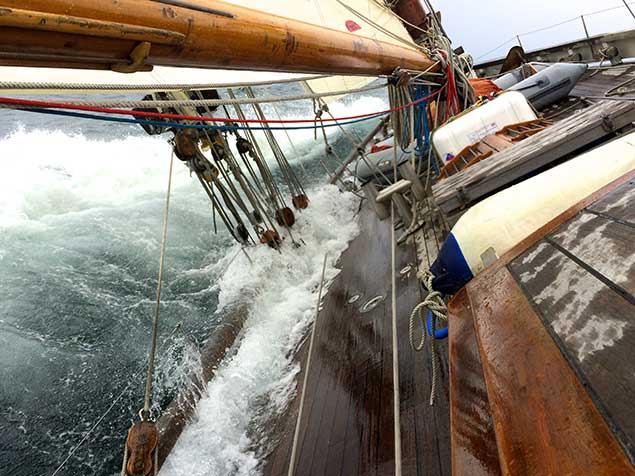 The rugged power of a seaworthy vessel – Annabelle J on passage from Smerwick Harbour in the Dingle Peninsula to Kilronan in the Aran Islands during her 2016 cruise on Ireland’s Atlantic seaboard Photo: Maire breathnach
The rugged power of a seaworthy vessel – Annabelle J on passage from Smerwick Harbour in the Dingle Peninsula to Kilronan in the Aran Islands during her 2016 cruise on Ireland’s Atlantic seaboard Photo: Maire breathnach
Today in Cork, the Irish Sailing Association/Cruising Association of Ireland Annual Cruising Conference is being staged, and it has attracted so much interest that the venue has had to be moved to larger premises than originally planned. As last night’s ICC AGM was a distinctly crowded affair too, clearly the interest in cruising is stronger than ever. But quite how many have managed to attend both events we won’t know until this morning, yet it’s just about possible with a bit of early morning discipline.
Then tomorrow, the focus swings northwestward from Cork to Foynes on the Shannon Estuary, where a Family Day from 2.30pm to 5.30 pm sees a celebration of Foynes Yacht Club becoming the new Volvo ISA Training Centre of the Year, with ISA President David Lovegrove doing the honours for a club which is the very essence of voluntary enthusiasm and community spirit.
Of course, many of the 200 or so young people who emerge from the Foynes Yacht Club Sailing Academy hope to go on to the highest level of racing success. But equally, they will find their talents in sailing much appreciated aboard keenly-sailed cruising boats. And the club has a solid record in offshore racing, with FYC’s Simon McGibney the current Commodore of the Irish Cruiser Racing Association, while father-and-son team Derek and Conor Dillon from Listowel have sailed their Dehler 34 under the Foynes colours to win the two-handed division in the Round Ireland Race.
And then beyond that, Foynes was home port to the great Conor O’Brien (1880-1952) of 1923-1925 Round the World fame. He lived out his final days on Foynes Island, and is buried in the nearby churchyard, but the recently-confirmed plans to build a replica of his famous 40ft ketch Saoirse in her 1922 birthplace of Baltimore will draw further favourable attention to everything that Foynes has done, and is doing, for Irish sailing – racing and cruising alike.
It’s all interconnected, for when the Irish Cruising Club was formed in Glengarriff on Bantry Bay on 13th July 1929, one of the first things they did was make Conor O’Brien an honorary member, and the first time I saw the noted portrait of Conor O’Brien sketched by his wife Kitty Clausen, it was in Foynes YC more than a few years ago..
 Always remembered. The model of Saoirse in Foynes Museum reminds us that she will soon be re-created full size
Always remembered. The model of Saoirse in Foynes Museum reminds us that she will soon be re-created full size
 The portrait of Conor O’Brien by his wife Kitty Clausen, seen for the first time in Foynes Yacht Cub.
The portrait of Conor O’Brien by his wife Kitty Clausen, seen for the first time in Foynes Yacht Cub.
So last night’s ICC post-AGM dinner was well peopled with friendly ghosts, but as well it was a celebration of some really remarkable cruises on every scale. Then too, it marked two significant changes of the watch with Peter Killen of Malahide, who led by example with his Amel Super Maramu 54 ketch Pure Magic seemingly always on the move, retiring as Commodore to see the to post go north to Stanton Adair of Belfast Lough, a long-serving committee member and flag officer who will be leading his members in the ICC Cruise-in-Company to the Galician Rias of Northwest Spain this summer in his well-travelled Beneteau Oceanis 43 Grand Cru.
However, while Commodores and other top officers may be the public face of the ICC, the strength of the club is in its voluntarily-produced publications, with Honorary Editors who between them keep the two volumes of Sailing Directions for the entire Irish coast up to date with notable rigour, and produce an Annual journal of the club’s cruising logs.
Norman Kean of Courtmacsherry is very much in charge of the Sailing Directions which are publicly available, and he’ll be one of the keynote speakers at today’s conference in Cork. But in their way the logs in all their rich variety in the Annual can be every bit as informative, particularly as the club is now so far-ranging that its members can be found cruising on most of the planet’s oceans.
Here, there has been another change of the watch, with Ed Wheeler from he north producing his final and as ever excellent Annual to cover the 2016 season, and after four years he hands over to noted sailor/musician/writer Maire Breathnach of Dungarvan. Or at least she’s from Dungarvan and she spends about a third of her time there, but as she’s married to another formidable voyager, Andrew Wilkes of Lymington on the south coast of England, they spend about a third of their time there, where - with other Irish ex-Pats - they’ve created a sort of West Hampshire Gaeltacht.
 Maire Breathnach off Cape Horn at the helm of Andrew Wilkes’ Swan 44 King of Hearts during their cruise round South America in 2004. Photo: Andrew Wilkes
Maire Breathnach off Cape Horn at the helm of Andrew Wilkes’ Swan 44 King of Hearts during their cruise round South America in 2004. Photo: Andrew Wilkes
 The new girl in town. Annabelle J as seen recently from Reginalds Tower in Waterford, with the sail training ketch Brian Boru astern. Photo Maire Breathnach
The new girl in town. Annabelle J as seen recently from Reginalds Tower in Waterford, with the sail training ketch Brian Boru astern. Photo Maire Breathnach
However, the remaining third of their time is maybe most interesting of all, as its spent aboard their gorgeous 55ft gaff cutter Annabelle J, which they bought about 18 months ago to replace their steel gaff yawl Young Larry, with which they’d transitted the Northwest Passage.
The 1996 steel-built Annabelle J first entered Irish maritime consciousness during her previous ownership in 2013, when she was undoubtedly the Queen of the Fleet during the Old Gaffers Golden Jubilee Cruise-in-Company, which took in both Dublin and Belfast. However, if you’ve progressed along the waterfront in Waterford recently, you’ll see her there near Reginald’s Tower, berthed just ahead of the Sail Training ketch Brian Boru, for she’s simply too big to fit into the handy little pool just below the bridge in Dungarvan which Young Larry used to make her winter home.
Although she’s “only” 55ft long in overall hull length, Annabel J is 66ft from nose to tail with spars included, and she speaks “ship” rather than “yacht”. The basic design was by David Cox completed by Gary Mitchell and she was constructed by shipbuilders A & P of Appledore in Devon. Yet while they admit to Bristol Pilot Cutter influence on her design, the original owners made no direct claims for this, but the fact is that she’s such a strikingly handsome vessel that it’s difficult not to see her as the definitive modern version of a pilot cutter, even if she’s larger than most of the original Bristol Channel boats.
For Maire and Andrew, taking on such a vessel was a leap in the dark until they could be confident they could handle her with just the two on board, but a cruise of Ireland’s west coast to Donegal and back in 2016 – including a transit of the Joyce Sound pass inside Slyne Head – showed them they could manage her both in confined waters and at sea, so for 2017 the far horizons call.
However, for 2017 there’s also the additional challenge that Annabel J is now editorial headquarters for the most important annual record of Irish cruising achievement, but her crew being aces in the communications business, they’ll take it all in their stride even if Ed Wheeler has left a very high standard to maintain.
For his final edition of the Annual, the adjudicator for 2016’s logs was former Commodore Cormac McHenry, himself a Transatlantic veteran, and although the ICC now has an enormous selection of trophies to highlight various specialities of achievement, nevertheless he had to by-pass some very notable cruises in order to make his final selection.
The ICC’s premier trophy, dating back to 1931, is the Faulkner Cup, and its latest award is to Daragh Nagle, a member based in Victoria on Canada’s west coast, from where he cruises extensively with his wife Cathy and others in his 1987-built Moody 376 Chantey V.
 Cathy & Daragh Nagle aboard Chantey V in the Sea of Cortez on the west coast of Mexico.
Cathy & Daragh Nagle aboard Chantey V in the Sea of Cortez on the west coast of Mexico.
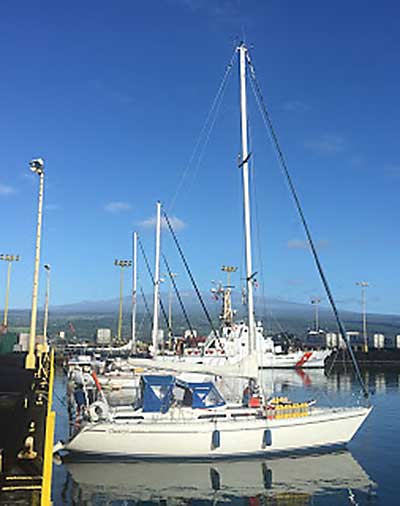 Chantey V is a standard Moody 376, designed by Bill Dixon and built 1986.
Chantey V is a standard Moody 376, designed by Bill Dixon and built 1986.
Chantey V’s 2016 cruise was from San Salvador on the Pacific Coast of Central America northwest along the Mexican coast to the long inlet of the Sea of Cortez, followed by the big ocean hop to the Hawaii Islands, before heading eastward back to Canada.
For the long haul out to the islands, he recruited Portuguese-based ICC member John Duggan as first mate, a role he filled with added diligence as he also obligingly wrote up the log of that stage of the voyage – other first mates please note. And as his skipper was unable to collect the Faulkner Cup last night in person as he is at a family wedding in Malaysia, John Duggan was in Dublin last night to do it for him.
His views on the Pacific between West Coast America and Hawaii were interesting. He says it may seem Pacific after you’ve battled your way round Cape Horn, but by comparison with his usual Atlantic stomping grounds, it seemed an oddly unsettled area of water, with twitchy little waves patterns running every which way.
 Man aloft. Daragh Nagle rigging an emergency inner forestay in mid-Pacific. Photo John Duggan
Man aloft. Daragh Nagle rigging an emergency inner forestay in mid-Pacific. Photo John Duggan
In fact, the going was so jerky at times that Chantey V broke her baby stay. The word from riggers is that the shorter the stay, the less able it is to absorb sudden snatches in loading. But whatever caused it, Darren Nagle spent a few hours getting well bruised at the lower spreaders before he’s rigged a satsfactory temporary baby stay to the stemhead to keep the rig in place for the rest of the voyage. By the time Chantey V got back to Victoria, this cruise totalled 7,858 miles for 2016, and just under 25,000 miles since they started their North America circuit three years ago.
As it happens, the Strangford Cup for an alterative best cruise goes to a venture which John Duggan has done a couple of times with his own 40-footer Hecuba, from the Iberian peninsula out to the Azores and then cruise in detail before returning to Spain or Portugal. In 2016 this very Atlantic cruise was undertaken by Seamus OConnor with his new Hallberg Rassy 42, and with three weeks in the Azores, he produced a mass of interesting information in addition to obviously enjoying himself, which is really what cruising is supposed to be all about.
Enjoyment takes many forms, yet cruising to northeast Greenland would not be many people’s first choice. But Brian Black of Strangford Lough finds he’s drawn back there seemingly year after year in his fairly standard 1985-built Trident Voyager Seafra. He writes of it in such an unassuming yet elegant way that his cruise first to the Faeroes then eastward of Iceland to Ittoqqortoormiit in northeast Greenland (it’s just south of the latitude of Jan Mayen) wins him the Wild Goose Cup for a log of real literary merit, and in it he finds the time to tell us of gig racing in the Faeroes and a visit to his favourite Arctic anchorage of Jyttes Havn.
 Gig racing in the Faroes as watched by Brian Black while cruising towards northeast Greenland. Photo: Brian Black
Gig racing in the Faroes as watched by Brian Black while cruising towards northeast Greenland. Photo: Brian Black
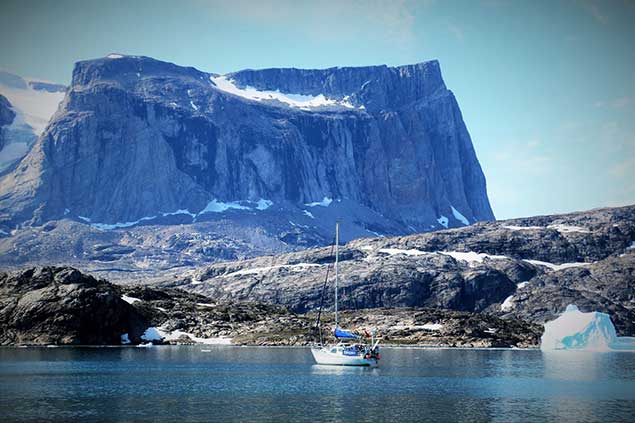 Favourite Arctic anchorage. Seafra in Jyttes Havn, Greenland. Photo: Brian Black
Favourite Arctic anchorage. Seafra in Jyttes Havn, Greenland. Photo: Brian Black
The sun may have shone for Seafra in Jyttes Havn, but far to the southwest in Labrador, Neil Hegarty and his shipmates on the Dufour 34 Shelduck found the weather classic Grand Banks cold and foggy as they readied their Dufour 34 Shelduck for a rugged but efficient passage to Baltimore in West Cork via Newfoundland to complete a three year Atlantic circuit which has been already been garlanded with awards, and now adds the Atlantic Trophy to its laurels.
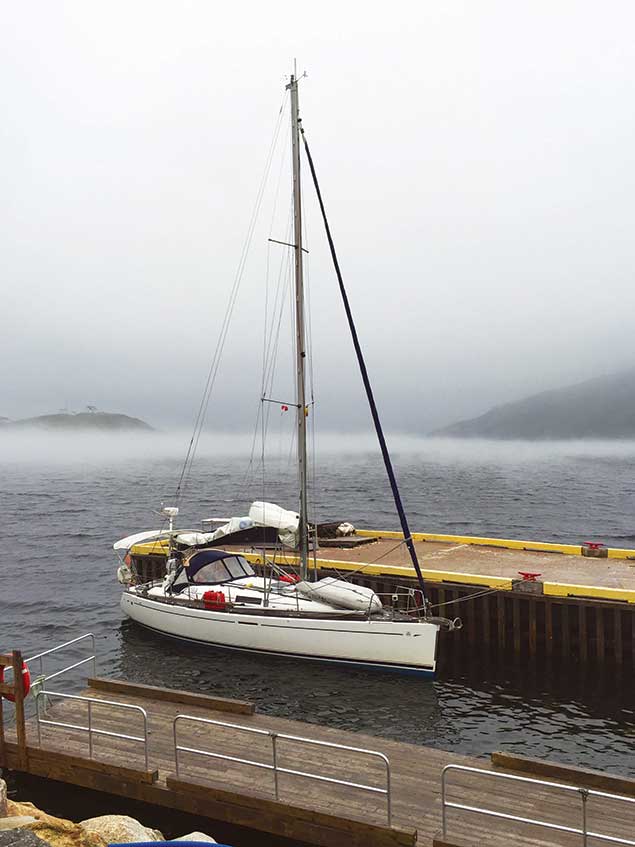 Cold and foggy. Neil Hegarty’s Shelduck at Red Bay, Labrador. Photo Neil Hegarty
Cold and foggy. Neil Hegarty’s Shelduck at Red Bay, Labrador. Photo Neil Hegarty
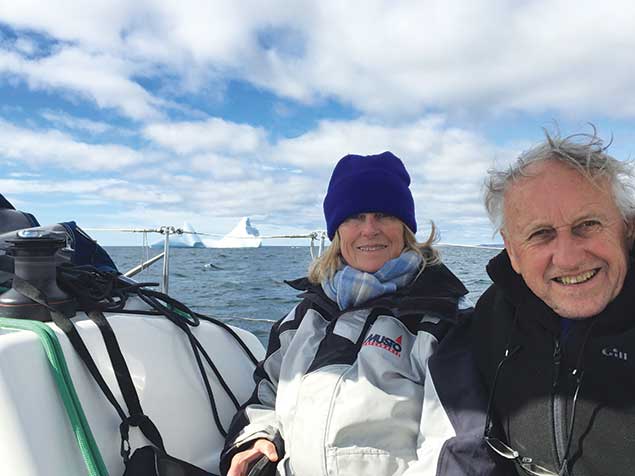 Homeward bound. Neil Hegarty (right) with Ann Kenny of Tralee and icebergs off St Anthony, Newfoundland
Homeward bound. Neil Hegarty (right) with Ann Kenny of Tralee and icebergs off St Anthony, Newfoundland
Even the briefest summary of the other main awards doesnl’t do them justice, but it gives some idea of the ICC’s level of activity:
Fortnight Cup: Best cruise within 16 days, Adrian & Maeve bell of Strangford Lough in the Baltic with their Arcona 430 Oisin Ban.
Round Ireland Cup: Donal Walsh of Dungarvan with his newly-acquired Ovni 385 Lady Belle. Thanks to his new boat’s lifting keel, not only was he able to explore shallow ports seldom visited such as Belmullet and Donegal town, but the fact that an Ovni is well able for seafaring meant he made St Kilda part of a round Ireland cruise while he was at it.
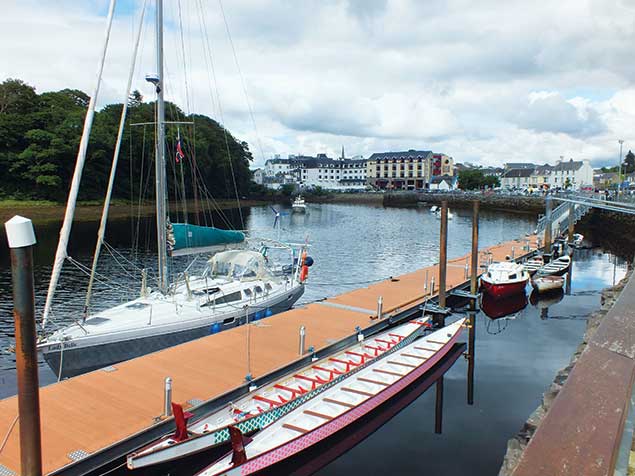 Donal Walsh’s newly-acquired Ovni 385 Lady Belle showing her versatility by comfortably finding enough water with keel raised to visit Donegal town (above), while she also made the passage out to St Kilda (below) with no bother. Photos Donal Walsh
Donal Walsh’s newly-acquired Ovni 385 Lady Belle showing her versatility by comfortably finding enough water with keel raised to visit Donegal town (above), while she also made the passage out to St Kilda (below) with no bother. Photos Donal Walsh

Fingal Cup: for the log which the judge most enjoyed goes most deservedly to Peter Fernie of Galway for a cruise round Ireland with co-owner Dave Whitehead in the Moody 27 Mystic. At least, it was basically round Ireland, but they also took part in the RUYC 150th Anniversary Cruise-in-Company with the ICC and the Clyde Cruising Club to Tobermorey, so through the minimum round Ireland circuit is 704 miles, the little Mystic had logged 1,228 miles by the time she got back to Kinvara.
Despite its many global adventures, the West Coast of Scotland still figures large in ICC activity, and it has its own trophy, the Wybrants Cup, awarded in 2016 to Robin & Denise Wright for a Hebridean jaunt including St Kilda in their 12m Jeanneau Geronimo.
And the charms of the Irish coast aren’t forgotten, they have their own Glengarriff Trophy, and most approoriately for 216 it goes to the new Annual Editor Maire Breathnach for her account of the mighty Annabel J’s stately progress up and down the Atlantic seaboard.
In fact, the Annabel J is the largest of the award winners this time round, and despite her traditional appearance, she’s also one of the newest. So anyone who has an image of the ICC as large glossy new yachts tearing about the ocean is somewhat mistaken, and the club makes a point of honouring its relatively humble origins with the Marie Trophy for the best cruise by any boat under 30ft. It celebrates the little 1893-built gaff cutter Marie which was the first awardee of the Faulkner Cup way back in 1931, and 85 years later, the Marie Trophy goes to Conor O’Byrne for his cruise from Gaway to the cruising paradise of southwest Ireland in the 1986-built Sadler 26 Calico Jack.
It says everything about the ICC’s breadth of achievement that the awards are only the tip of an iceberg of seagoing coasting and island-hopping variety. One particularly notable cruise which didn’t get any nod of special recognition was from Galway Bay to Russia by Fergus and Katherine Quinlan with their own-built van de Stadt 12 metre steel cutter Pylades, a wonderfully detailed account of many countries which contrasts very vividly with their previous big venture, a voyage round the world.
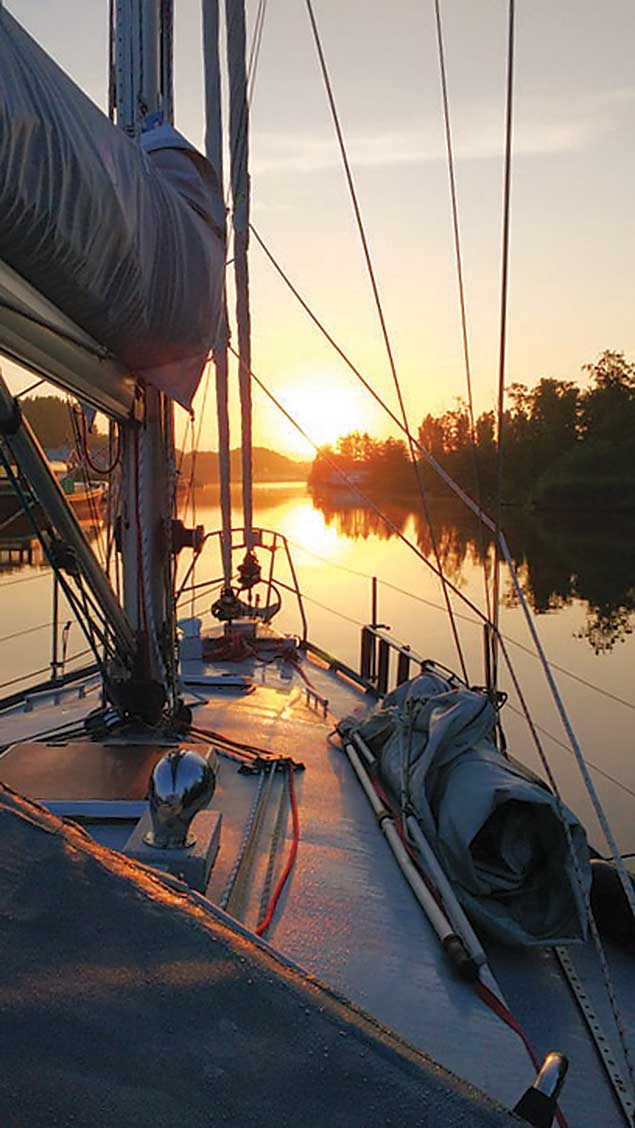 A long way from Pacific Islands. Dawn beyond the Ijsselmeer in the Netherlands, as seen from Pylades during the cruise to Russia. Photo: Fergus Quinlan.
A long way from Pacific Islands. Dawn beyond the Ijsselmeer in the Netherlands, as seen from Pylades during the cruise to Russia. Photo: Fergus Quinlan.
But then that world circuit saw Pylades being awarded the Faulkner Cup three years on the trot, so maybe there’s room for a new trophy “For A Cruise Which Is As Different As Possible From The Same Vessel’s Previous Award-winning Cruise”.
And then there’s no award for a cruise which provides photos which best capture the sprit of a cruising area, but for 2016 it would have gone to Paul Newport of Howth, whose cruise his wife Fiona to the Hebrides with the Najad 332 Puffin Eile was not only a gem of its type, but he brought back a couple of photos which make the place live for the rest of us.
The more dramatic is taken into the sun at Cragaig Bay on the island of Ulva west of Mull, with the distinctive Dutchman’s Cap island in the distance. In the foreground are four cruising yachts, all lying to their own anchors in the approved manner, all at a distance from each other which is enough for politeness and privacy, yet they’re not so far apart that there can’t be some sociable interchange if it is mutually wished.
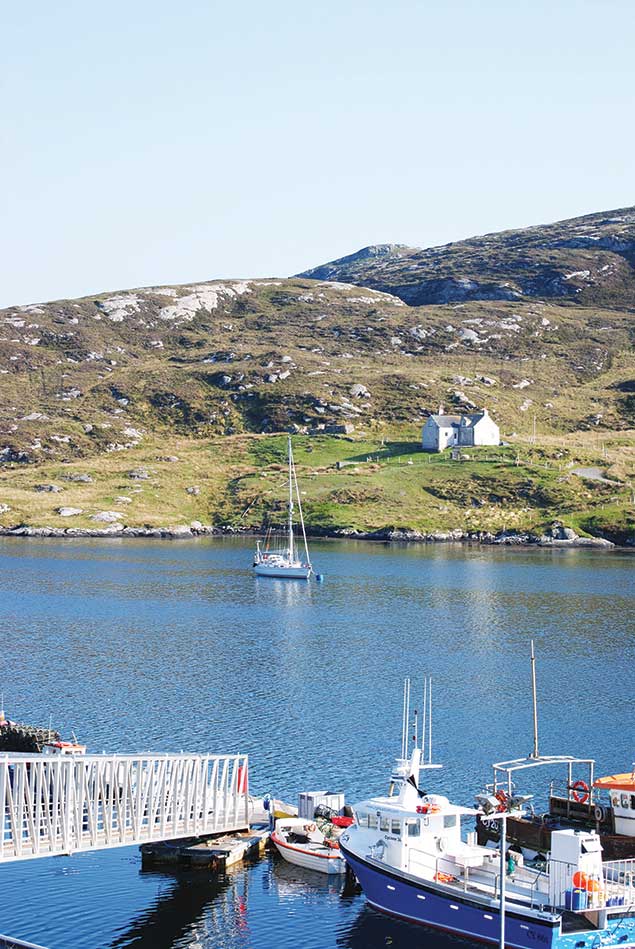 The most perfect small Hebridean island…..Puffin Eile at Eriskay. Photo Paul Newport
The most perfect small Hebridean island…..Puffin Eile at Eriskay. Photo Paul Newport
The other is simply Puffin Eile lying to the visitor’s mooring in the lovely little island of Eriskay. Eriskay is so perfect that when we first went there, one of my shipmates was so impressed that he duly named his next boat after it. Yet somehow timetables in cruising the Outer Hebrides recently have meant that we’ve missed out on Eriskay while passing south or north through the Sea of the Hebrides, so it’s good to see the little place looking so well.
Getting a special satisfaction out of sailing your own boat to places like Eriskay is part of what cruising is all abut. But there are many other factors which contribute to true enjoyment of this mainstream yet low-profile aspect of sailing, and one of them is good food.
So it’s a brilliant idea that Rachel Allen of Ballymaloe should be another of the key speakers at today’s Cruising Conference in Cork. Only recently she featured here in Afloat as Olympic Silver Medallist Annalise Murphy has been doing the intensive 12-week Cookery Course at Ballymaloe, which is definitely not an undertaking for the faint-hearted.
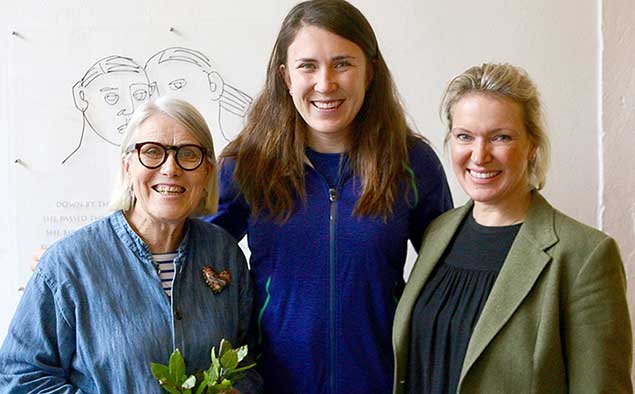 Darina Allen, Olympic Silver Medallist Annalise Murphy, and Rachel Allen at Ballymaloe Cookery School.
Darina Allen, Olympic Silver Medallist Annalise Murphy, and Rachel Allen at Ballymaloe Cookery School.
But Ballymaloe’s connections with sailing are much wider than that, for it was windsurfer Rory Allen of Ballymaloe, who started the famous Round Great Island Race in Cork Harbour scheduled at the top of the tide, and it’s now an annual highlight. And Rachel herself is of the O’Neill sailing family, whom we’ve known afloat for many years. It goes back a very long time to when they’d the Nicholson Half Tonner Silver Mite, and we buddy-boated together from West Cork home to Dublin in good company with Denis and Brian O’Neill. The latter very obligingly hauled one of the Nixon kids out of Kinsale Marina when he fell in while being over-enthusiastic about fishing. I’m happy to tell “Disgusted of Dunmanway” that the young fisherman was wearing a lifejacket, but the O’Neill pull-up was very much appreciated nevertheless.
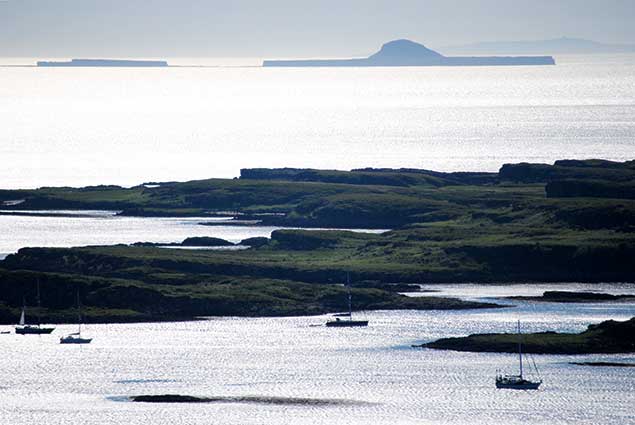 The cruising dream on Scotland’s West Coast. The anchorage at Cragaig Bay on Ulva off the west coast of Mull, with the distinctively-shape Dutchman’s Cap island beyond. Photo Paul Newport
The cruising dream on Scotland’s West Coast. The anchorage at Cragaig Bay on Ulva off the west coast of Mull, with the distinctively-shape Dutchman’s Cap island beyond. Photo Paul Newport
Afloat's WM Nixon Will Tell Galway Sailors That Irish Were First To Leave Gaff Rig
Afloat.ie’s W M “Winkie” Nixon will be talking the talk at Galway Bay Sailing Club’s mid-week gathering at 8pm on Wednesday, February 1st in the re-vamped clubhouse at Rinville in Oranmore, and all are welcome.
The hospitable GBSC clubhouse is at the heart of one of the main sailing centres on a coastline as much renowned for its association with gaff-rigged traditional craft as it is for being the base for some of Ireland’s most modern offshore racers. But in a wide-ranging profusely-illustrated talk, one of the points Nixon will be making is that it was leading Irish amateur sailors who were in the forefront of the changeover from gaff to Bermudan rig.
Drawing on his extensive experience of sailing both abroad and in Ireland (which he has cruised or raced round more times than he can remember), as a sailing journalist and historian Nixon has discerned significant sailing trends which first emerged in Ireland, but became obscured by major national historical events.
However, he promises that the main theme of his talk – “When Gaffers Weren’t Old” – is the sheer pleasure and fascination of sailing. Admission is free and open to all, but a seaboot at the door will be there to receive €5 from anyone who feels like contributing to the Lifeboats.
Wicklow Sailing Club are best-known as the big-hearted little organisation which keeps the iconic Volvo Round Ireland Race show on the road with such style that it is now one of Europe’s premier events, with a stellar international entry list of 63 boats – many of them world famous - in June 2016. But where some other smaller clubs might find their own members’ sailing activities distorted or diminished through the voluntary organisational effort which is required to keep a biennial mega-event on this scale running smoothly, in Wicklow the reverse is true writes W M Nixon.
The big race – at 704 miles it is nearly a hundred miles longer than the other classics such as the Fastnet, the Sydney-Hobart, the Caribbean 600, the Bermuda Race and the Middle Sea Race – is run with the full co-operation of the RORC, and back-up support from the Royal Irish YC in Dun Laoghaire. Yet in Wicklow the club spirit is such that not only are there volunteers ready and willing to provide further assistance to key personnel such as the Volvo Round Ireland Race Organiser Theo Phelan and his team, but there is ample evidence that this high level of voluntary effort spreads into every corner of club activity. This is particularly the case with a thriving junior training and racing programme, in which the leading figures have been Dave Ballesty and Mark Redmond.

 Wicklow in a different mood, as it might be seen while cruising, with a couple of visiting yachts in port including a pretty little schooner, and the Wicklow SC junior training squad heading back towards the club after a day’s instruction afloat. Photo Mike Harper
Wicklow in a different mood, as it might be seen while cruising, with a couple of visiting yachts in port including a pretty little schooner, and the Wicklow SC junior training squad heading back towards the club after a day’s instruction afloat. Photo Mike Harper

Anyone who has been in Wicklow for the impressive, crowded and colourful Seafest which is clustered around the Volvo Round Ireland Race start at the midsummer weekend will have naturally tended to assume that, after the big event has been tidied up and its week of long-distance racing rounded out with the Friday night prize-giving, Wicklow sailing takes a well-earned rest.
Not so. The Round Ireland tents are folded away, and the real Wicklow, la Wicklow profonde, will have emerged within days. Toppers, Lasers, Picos and other two-handed dinghies will flock seaward for training, accompanied by busy instructor RIBS zooming about to encourage yet another new generation into proper sailing in a club which has produced notable sailors on the national and international scene such as Round Britain and Ireland two-Handed winner Brian Flahive, Commandant Barry Byrne the winning Skipper of the inaugural Beaufort Cup at Volvo Cork Week in 2016, award-winning international cruising man Alan Rountree who self-built – to an immaculate level – his much-travelled 34ft sloop Tallulah, and the popular Charlie Kavanagh, whose abilities as a seaman and sailing teacher are deservedly renowned.
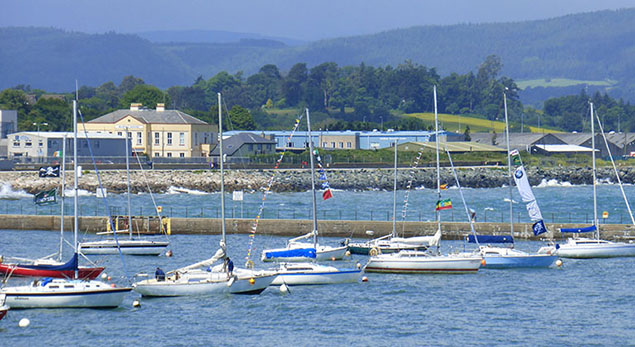
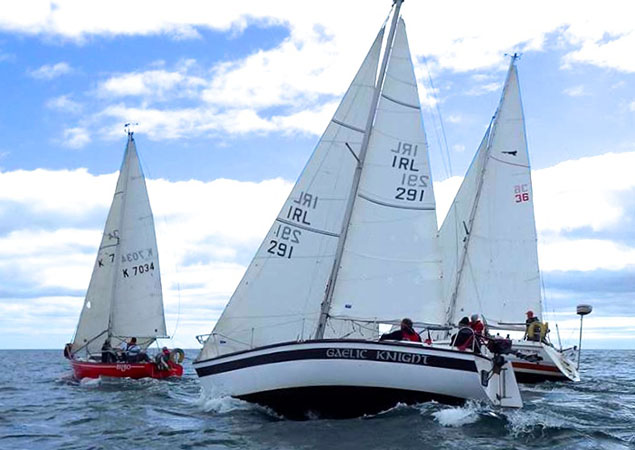 Wicklow cruisers in action for a club race, WSC has produced several sailors of national renown
Wicklow cruisers in action for a club race, WSC has produced several sailors of national renown
But being Wicklow, these kids coming up through a club which has been producing distinguished sailors since its foundation in 1950 will have voluntarism in their genes. Wicklow SC has only around 160 members, of whom barely a hundred are full adult members. Yet not only most of the adults, but many of the young people too, see voluntary work for the club - both in keeping its activities at a high level while maintaining its fabric and the fleet of club-owned training boats in proper order – as part of the Wicklow way of doing things. And of course among all sailing folk, whether racing or cruising, dinghy or offshore, Wicklow Sailing Club is a byword for hospitality and making newcomers welcome to our sport.
 Getting them started. Guidance and instruction from Dave Ballesty for a group of junior trainees.
Getting them started. Guidance and instruction from Dave Ballesty for a group of junior trainees.
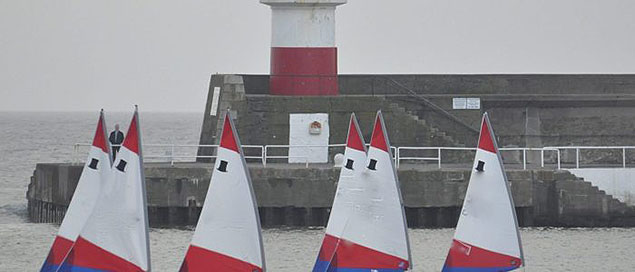 An unexpected bit of colour co-ordination for Wicklow’s famous lighthouse and the local Topper fleet
An unexpected bit of colour co-ordination for Wicklow’s famous lighthouse and the local Topper fleet
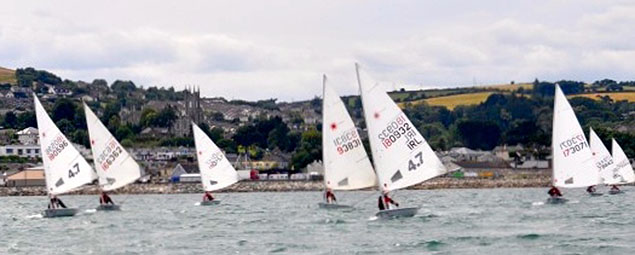 Lasers racing at Wicklow over the same waters where the Volvo Round Ireland start is staged, and where the finish is fought out
Lasers racing at Wicklow over the same waters where the Volvo Round Ireland start is staged, and where the finish is fought out
 Wicklow Harbour seen from the southeast. It takes ingenuity and dedication to run a successful sailing club in what is essentially a busy small commercial port
Wicklow Harbour seen from the southeast. It takes ingenuity and dedication to run a successful sailing club in what is essentially a busy small commercial port
With a thriving club life, it also plays a key role in its local community. Yet at the same time, every two years since 1980 it has organised the Round Ireland Race. And though there have been years when the entry has been thin enough, in 2016 everything came together with glorious success for a club which simply never gave up on the idea that a proper Round Ireland Race was central to the entire Irish sailing scene.
To say that the race organisers down the years since 1980 have beavered away behind the scenes to keep the show on the road only hints at the effort sometimes required to enable an event of this stature to fulfill its true potential. But since 2012, current organizer Theo Phelan has been working with a special statesmanlike dedication – some would call it Machiavellian skill – to raise the event onto a new plane. By 2016, with the full support of the RORC and its Irish Commodore Michael Boyd, together with the discreet assistance of the Royal Irish Yacht Club in Dun Laoghaire in order to provide a pre-race base for larger yachts, and the added involvement of superstar multi-hulls to make full use of a package which now included sponsorship from Volvo Car Ireland, the Round Ireland Race came of age and entered the big boys league.
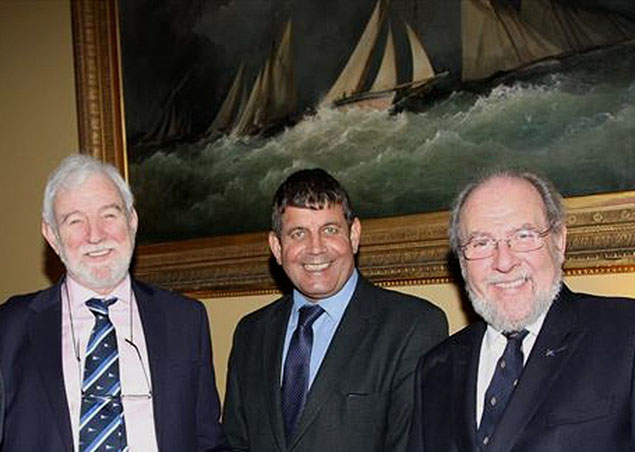 Spreading the support base. Round Ireland Race organiser Theo Phelan (left) with Wicklow TD Andrew Doyle, and Jim Horan, Commodore of the Royal Irish Yacht Club
Spreading the support base. Round Ireland Race organiser Theo Phelan (left) with Wicklow TD Andrew Doyle, and Jim Horan, Commodore of the Royal Irish Yacht Club
Yet this all was done from one tiny club in a workaday commercial and country town whose small port has a very strong commercial bias. But when something is functioning as perfectly as Wicklow Sailing Club and the Volvo Round Ireland Race in 2016, perhaps it’s better not to dissect it all in too much detail. You might break the magic spell. So instead, we’ll just try and tell you who does what, and hope the story speaks for itself.
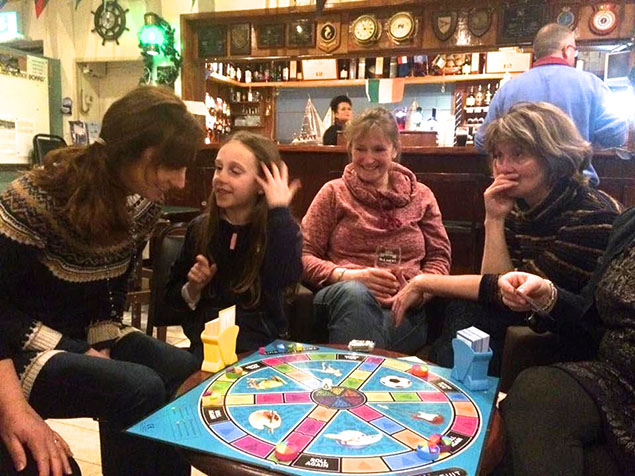 In addition to its major role in sailing, Wicklow SC is very much a community focus with an emphasis on family life – this is a Games Night for all ages in the Clubhouse
In addition to its major role in sailing, Wicklow SC is very much a community focus with an emphasis on family life – this is a Games Night for all ages in the Clubhouse
Wicklow Sailing Club has learned to live with the biennial appearance of the big one by ensuring that the Commodore’s two year term sees that the Round Ireland Race – which has to be in a non-Fastnet year – will be happening in the second year of office, when he or she is well settled into the top role. But even this was something which had to be learned, and the club is eternally grateful to a former Commodore Johnny Johnson, who gallantly served three years in order to get the sequence right.

 Round Britain & Ireland Two-handed Winners Liam Coyne & Brian Flahive were conferred with Honorary Membership of Wicklow SC – (left to right) Liam Coyne, WSC Commodore Hal Fitzgerald, President Sadie Phelan, and Brian Flahive.
Round Britain & Ireland Two-handed Winners Liam Coyne & Brian Flahive were conferred with Honorary Membership of Wicklow SC – (left to right) Liam Coyne, WSC Commodore Hal Fitzgerald, President Sadie Phelan, and Brian Flahive.
However, when you’re drawing on such a small membership, the succession has to be carefully planned to make best use of the limited pool of talent, and when Wicklow Sailing Club’s officer and committee board underwent its usual total biennial change just ten days ago, Hal Fitzgerald stood down after his two year term as Commodore to be succeeded by Denise Cummins, who had been Honorary Secretary and thus will be tuned to every nuance of club life and administration when the Volvo Round Ireland Race 2018 comes roaring over the horizon.
Last year’s full list gives an idea of the many talents needed to keep any club operating smoothly:
Wicklow Sailing Club - 2016
Officers, General Committee and Sub-committees
President: Sadie Phelan
Commodore: Hal Fitzgerald
Vice-Commodore: Brian Malone (Lead for Try Sailing - Cruisers)
Rear Commodore Sailing: David Ryan (lead for Berthing Round Ireland)
Rear Commodore House: Gerry Nolan (Long standing, long serving member, came to cruisers after many years on the GP 14 circuit)
Hon. Treasurer: Fergus Somers (Lead for Finance Ctte)
Hon. Secretary: Denise Cummins
Membership Secretary: Joanne Logan (& Finance Ctte)
General Committee:
Dave Ballesty (ISA Training Centre Principal, Try Sailing – Dinghies, & lots of other work), Eugene Lynch (Communications & VRIYR Official Race Programme), Roisin Hennessy (Lead for Dinghies), Paul Hennessy, Kyran O Grady (Lead for boat maintenance & house fabric), Peter Shearer, Angela Higgins (Ballesy) (Lead for Grants & Club Development).
Volvo Round Ireland Yacht Race Organising Committee:
Chair & Secretary: Peter Shearer
Race Organiser: Theo Phelan
Asst Race Organiser: David Ryan
Commodore ex officio: Hal Fitzgerald
Volvo Round Ireland Yacht Race Catering Committee:
Sandra Fitzgerald, Liam Whitty, Paul Hennessy PLUS many, many volunteers, particularly those who fed the returning boats.
ISA Training Centre Principal: Dave Ballesty, assisted by Mark Redmond and Roisin Hennessy
However, in a club of this size it would be very counter-productive if people insisted on a clear job description, and stuck rigidly to their own interpretation of the brief. A delicate balance has to be drawn and maintained between recognizing who is ultimately responsible for some task, yet being prepared to leap in to do the job or at least assist with it during periods of particular stress.
And of course in a town like Wicklow – which mercifully is just far enough from Dublin to be its own place, healthily clear of rigid metropolitan attitudes – there’s interest in how people spend their time in their day jobs, and the lineup keeping the Wicklow SC machine moving along includes the talents of one of Ireland’s leading thatchers, Kyran O’Grady, who in 2017 takes on the additional role of Honorary Treasurer, whole another key figure is David “Farmer” Ryan who organised the participation of the Volvo 70 Monster Project in the 2014 Race, and is getting his sailing off to an early start this year with participation in the RORC Caribbean 600 in February.
As for the season of 2016, everyone will be well aware that in the Volvo Round Ireland Race for mono-hulls, the overall winner, line honours winner and establisher of a new record was George David with Rambler 88, while the multihull winner – by a matter of seconds – was Oman Sailing (Sydney Gavignet), which also established a new record.
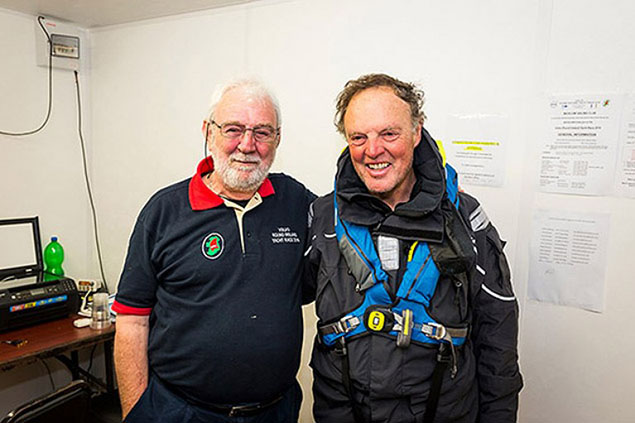 Theo Phelan and RORC Commodore Michael Boyd immediately after the latter had taken third place overall in the Volvo Round Ireland Race 2016.
Theo Phelan and RORC Commodore Michael Boyd immediately after the latter had taken third place overall in the Volvo Round Ireland Race 2016.
But for aficionados, perhaps the most popular prize was what might be called the Corinthian Award, which doesn’t actually exist, but if it did who would have gone to RORC Commodore Michael Boyd who took third overall in the standard First 44.7 Lisa after sailing a virtually faultless race, a race which incidentally he won overall in 1996, racing the J/35 Big Ears.
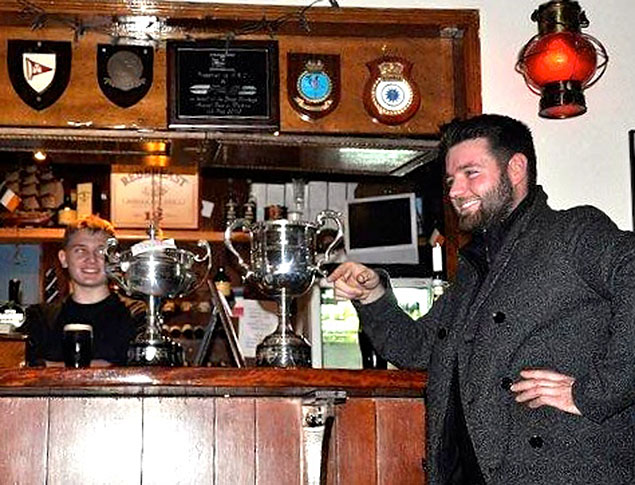 Jason Moran with his 2016 club trophies won with his Hydro 20 Hydrogin
Jason Moran with his 2016 club trophies won with his Hydro 20 Hydrogin
Once it was all over, Wicklow life resumed, and local racing saw Jason Moran with the David Thomas-designed Hyrdo 28 Hydrogin win the cruiser classes, while the dinghy events were dominated by the annual Junior Regatta which produced a wide spread of results, and here’s a photo of the winners:
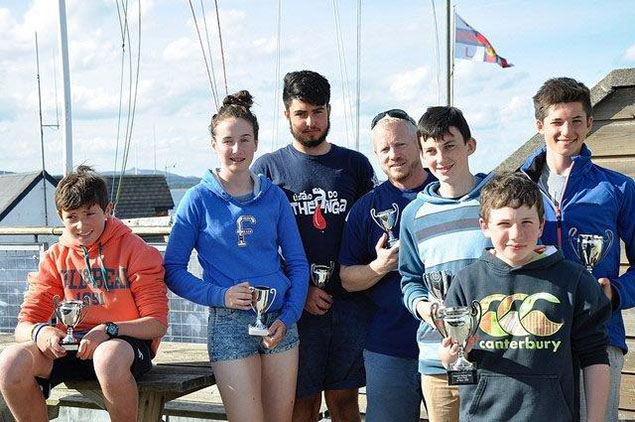 Winners at the 2016 WSC Junior Regatta were (alphabetically) Cillian Ballesty. James Beattie Doyle, Ryan Fitzgerald, Charles Heather, Rick Johnson, Isobel O’Grady, and “a visitor from Courtown Sailing Club”.
Winners at the 2016 WSC Junior Regatta were (alphabetically) Cillian Ballesty. James Beattie Doyle, Ryan Fitzgerald, Charles Heather, Rick Johnson, Isobel O’Grady, and “a visitor from Courtown Sailing Club”.
Wicklow Sailing Club last won the “Club of the Year” award in 1979. In those pre-Round Ireland days, they were experimenting with events which would make sailing more accessible, and Irish ports more welcoming, to sailors from elsewhere. So they staged a sort of cruising rally open to absolutely everything which floated, and from anywhere, and it worked very well to be the highlight of a busy season for a club which was starting to find its feet.
They’ve certainly found their feet very well indeed now. The entire Irish sailing community owes a mountain of gratitude to Wicklow Sailing Club for never losing the faith on the Round Ireland race, and bringing it to its present eminence through sheer dogged persistence, and an awesome amount of hard work, nearly all of it voluntary. They become the very worthy Mitsubishi Motors “Sailing Club of the Year” 2017.
 It is not generally known that Wicklow is in a unique micro-climate where sub-tropical conditions are frequently experienced, and Junior Instructors have to take special steps to protect themselves from the sun’s rays.
It is not generally known that Wicklow is in a unique micro-climate where sub-tropical conditions are frequently experienced, and Junior Instructors have to take special steps to protect themselves from the sun’s rays.
2017 Irish Sailing Fixtures Preview
The only non-elitist thing about the Olympic Games is the fact that all countries – however large or small – are treated equally. A small country like Ireland is entitled to exactly the same number of places in competition as the superstates like the US or China. But apart from that, if any country’s national authority in any Olympic discipline is not treating its selected athletes as a pampered elite as an Olympic year arrives, then it is wasting everyone’s time. That’s how it should be in an Olympic year. But things definitely aren’t the same in the three clear years between each Olympiad. W M Nixon looks ahead to a completely different type of season in 2017.
Irish sailing had a good 2016 Olympics. Our waterborne elite did well - they did us proud. And the Irish national sailing season of 2016 – as we saw in last weekend’s review here – was special in many ways, for on top of Olympic success we staged two major world dinghy championships, witnessed perhaps the best ever Volvo Round Ireland Race, and brought home both silver and bronze medals from world youth championships.
That was how it was in 2016. But for 2017, we look forward to a very different kind of sailing year, in which everyone has the chance to be a star at local level, and our Olympic achievers and international medallists will be sailing as ordinary competitors along with everyone else.
 Olympic Silver Medallist Annalise Murphy racing her foiling Moth, with which she is expected to compete in the Cork Dinghy Fest at the end of June. Photo: VDLR
Olympic Silver Medallist Annalise Murphy racing her foiling Moth, with which she is expected to compete in the Cork Dinghy Fest at the end of June. Photo: VDLR
In these circumstances, it’s intriguing to look at some of the events which will set the tone for the coming year. And if by some chance you’re feeling jaded as we sink into the depths of winter, rest assured that it’s an absolute tonic to talk with the voluntary organisers who are heading up the groups which are putting together the various packages which will provide sailing happenings of all sizes from one end of the country to the other.
These people have a level of infectious enthusiasm which, if you could bottle it, would make you a fortune. Their zest in our sport, and their joy in boats and the sailing of them, is a wonder to behold. And they’re so keen on it that they’re prepared to put in so very many hours of their free time – hours beyond measure, in fact – in administrative effort, that it would put many professional organisers to shame.
Such enthusiasm can bring its own special problems. Every sailing centre round the coast and on the lakes will expect its share of the action. So inevitably there will be a clashing of dates which will make for difficult choices for crews who had specific programmes in mind. But this morning, we’re not in the mood to beat the drum about ruthlessly rationalising the national programme. Let’s just tell you what’s happening, and you can draw your own conclusions and plan out your own season.
That said, the big one is undoubtedly the Volvo Dun Laoghaire Regatta from the 6th to 9th July. 2015’s staging of this biennial festival experienced a quantum leap in the scale and scope of the event. Somehow, it moved onto a new plane. Under the chairmanship of Tim Goodbody, the organising committee built on the efforts of previous years, and the resulting myriad of sailing became a wonder to behold, and a joy to take part in. The plan for 2017 is to make it even better.
This outline hints at the scale of the event which will take place in July:
Volvo Dun Laoghaire Regatta 2017
Racing open to 30 Classes.
Incorporating the following Championships:-
· Royal Dee Yacht Club Irish Sea Offshore Championship
· Sigma 33 and Wayfarer National Championships
· Beneteau 211 Irish Championship
· GP14 and 420 Leinster Championships
· SB20 Southern Championship
· J24 & Squib East Coast Championships
Celebrating 200 years of Dun Laoghaire Harbour:
The Kingstown 200 Trophy for the best classic keelboat/dinghy.
NOR and Online Entry will open mid November (Monday November 14th).
Super Early Bird Entry Prize Draw: All entries received and paid for in full by 31 December 2016 will automatically be entered into a Super Early Bird Prize Draw and 10% of these lucky people will have their Entry Fee refunded.
To get the flavour of it, a chat with Organising Chairman Tim Goodbody at mid-week brought everything to life. That said, he was in a thoughtful mood, as that morning he had sold his much-loved Sigma 33 White Mischief after seventeen very happy and successful years. This enthusiasm in talking about their boats was found to be a shared characteristic of all the voluntary organisers, something which those who think the future of sailing lies in group-owned professionally-maintained boats might like to ponder.
Be that as it may, the J/109 class in Ireland will be taking on board the fact that their newest star entrant Tim Goodbody is now a hundred per cent J/109 man. For until he was comfortable in the knowledge that his Sigma 33 White Mischief had gone to a good home (she has found a lucky owner in Arklow), you had the feeling that a tiny bit of his mind was elsewhere as he campaigned the new White Mischief, a J/109.
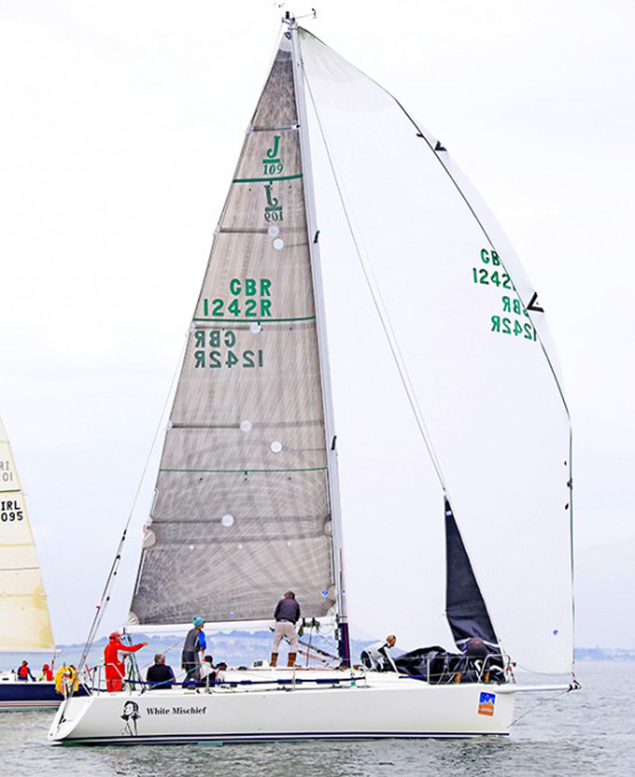 No longer a fleet owner…..Tim Goodbody’s J/109 White Mishcief is now his only racing steed. Photo: Afloat.ie
No longer a fleet owner…..Tim Goodbody’s J/109 White Mishcief is now his only racing steed. Photo: Afloat.ie
That said, he was frequently on the podium in the new class, but for Volvo Dun Laoghaire Regatta 2017 the rest of his crew will have to race as best they can without him, for he throws himself so thoroughly into heading up the large army of VDLR volunteers – with Ciara Dowling as an awesomely effective Executive Secretary – that there simply isn’t the time to think of campaigning in one of the hottest of the 30 classes as well.
A look at the heights of the 2017 programme shows how it is quite an achievement for the Volvo Dun Laoghaire Regatta 2017 to be the peak event at home, and it also reveals the difficulty for planning a programme for your boat and crew which will keep everyone – including the Commodore of your home club – in a happy frame of mind.
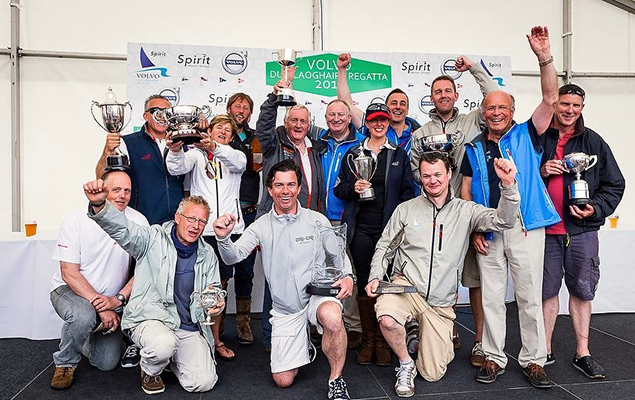
This list is by no means complete, but if you haven’t firmed up your club or association schedule by November, you’re not going to be taken seriously, as November is traditionally the month when the next year’s Corinthian crewing programmes take shape.
2017 Preliminary Programme
March 25th Horizon Energy Group PY1000 in Owenabue River at Crosshaven (RCYC)
May 26th – May 29th Scottish Series (Clyde Cruising Club)
June 3rd Lambay Races (Howth)
June 9th- June 11th ICRA Nats (Royal Cork)
June 14th Dun Laoghaire to Dingle Race (National YC)
June 21st to 24th Sovereigns Cup (Kinsale)
June 30th – July 2nd Cork Dinghy Fest 2017
July 6th to 9th Volvo Dun Laoghaire Regatta
July 6th to 8th WIORA Championship, Aran Islands
July 23rd to 28th Glandore Classics
August 1st to 4th Calves Week (Schull)
August 6th 2017 Rolex Fastnet Race
August 14th – 18th Half Ton Classic Worlds (Kinsale)
October 21st Rolex Middle Sea Race
We happen to know about the first rather esoteric major event on the programme, the PY 1000 dinghy race in the Owenabue River at Crosshaven on March 25th, thanks to the enthusiasm of Nicholas O’Leary of Royal Cork. He’s back on home ground and busy with being the third generation of his family in the energetic and imaginative organisation and promotion of sailing.
The Horizon Energy Group PY 1000 is a come-all-ye for dinghies using the Portsmouth Yardstick handicap. And they don’t mess about with prizes – there’s €1,000 on it. As the tides suit, they’ll be using the full available length and breadth of the Owenabue River between Crosser and Carrigaline in a crazy sailing project to blow the winter cobwebs away, and it will be a useful training for ogranisational energy levels as young O’Leary puts his team through their paces in training for the Cork Dinghy Fest at the end of June.
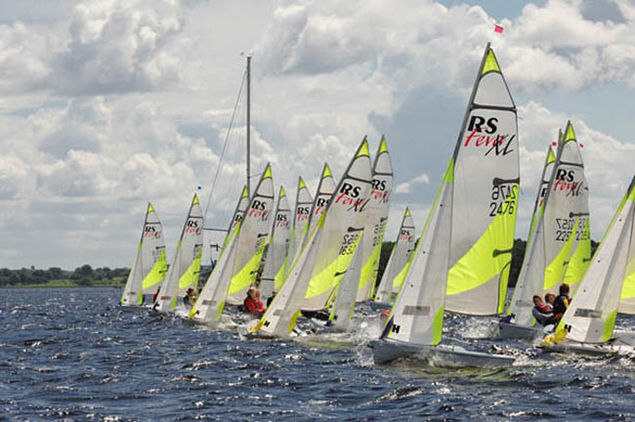 RS Fevas in a National Championship on Lough Ree. They’ll be gathering with other classes in Cork at the end of June 2017
RS Fevas in a National Championship on Lough Ree. They’ll be gathering with other classes in Cork at the end of June 2017
Like Tim Goodbody, he can be slightly sentimental about his boats – in his case, it was seeing an old and much-loved Optimist he’d once raced which fired him up to spread the news. An email from him this week gets the flavour of Nicholas O’Leary’s approach to sailing:
“Top of the organisational agenda is taking on the Dinghy Festival at the end of June on behalf of the Royal Cork Yacht Club and the dinghy fraternity of Ireland and beyond. My good friend Marty O’Leary is chairman of the RS Class in Ireland, and we will again welcome three fleets from under his wing - The RS200 for their Nationals and the RS400 and Feva Southerns.
The array of dinghy classes within Ireland concentrate on doing their own calendar year after year. This is a huge undertaking and requires massive dedication by class captains, regional reps and the clubs that host. The Dinghy Fest takes the stress off such class reps for one of many events they would normally have to organise, and brings together the masses into one harbour to enjoy great racing and great craic ashore, particularly as it provides socialising with friends they haven’t seen due to other class commitments.
We are working on connections within the variety of classes nationwide, and one exciting grouping that we’re planning is an Extreme Fleet. To see one 49er screaming across Cork Harbour is a sight, but we plan to have one race course dedicated to an entire fleet of fast dinghies, with the foiling Moths - where we hope to see Olympic Silver Medallist Annalise Murphy racing against her coach Rory Fitzpatrick - as well as 29ers and 49ers, and the Cat class, with the Catamarans demonstrating their viable concept of mixed craft racing on the one race track, and results divided thereafter.
I know this Extreme Fleet will open the eyes of young sailors to see that there is life after an Optimist, 420, Laser or whatever fleet they are currently in, and that fast fun boats are accessible classes, alive within Irish waters. I sincerely think it’s very important for the future of youth sailing that they enjoy it, finding a class they are happy in rather than being marched up to the gates of a pathway and pushed through. Those who enjoy the sport will stay in the sport. If they excel to greater heights, then so much the better, but that shouldn’t be the be-all and end-all for everyone.
I don’t believe the success of an event is within its number of entries, but in its quality of racing provided. That is why my old housemate and current ISA Champion of Champions Alex Barry is joining our team in an advisory role to keep the high standard of racing up to scratch, and in line with what we would expect when racing Worldwide. I look forward to developments in the months to come, and will of course keep everyone updated with sailing news from near and far.”
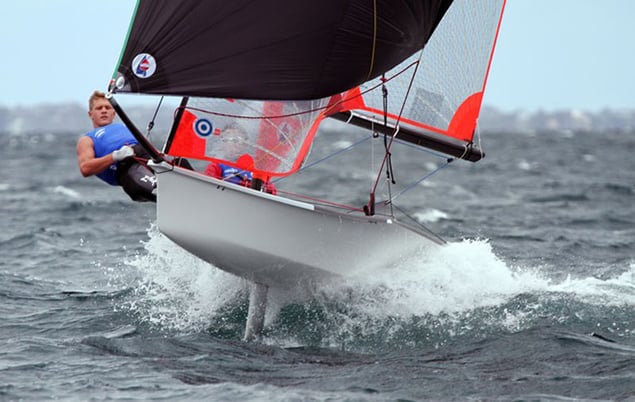 29er in flight. Nicholas O’Leary, organiser for Cork Dinghy Fest 2017, hopes that the presence of 29ers will encourage more young sailors to realize that boats like this aren’t only for the elite
29er in flight. Nicholas O’Leary, organiser for Cork Dinghy Fest 2017, hopes that the presence of 29ers will encourage more young sailors to realize that boats like this aren’t only for the elite
So the dinghies of Ireland have the good example of somebody thinking in a far-sighted and coherent way. But with the offshore racers, the picture is as ever more complex. Yet it’s for sure we’re interested in the Scottish Series out on its own in May, as we provide the ex-Pat overall winner Dara O’Malley (originally from Westport, he’s Edinburgh-based) with his Hunter 707 Seaword in 2016, while regular contender John Hall from the National YC won Class 2 with his J/109 Something Else.
But in June things get mighty complicated, as there are two major cruiser-racer championships in Cork with a clear fortnight between them, yet during that fortnight the biennial Dun Laoghaire to Dingle race gets under way.
However, if you talk with the enthusiasts involved in organising any of these events, it all seems very manageable. Paul Tingle who is chairman to organise the ICRA Nats at Royal Cork from June 9th to 11th has recently moved from campaigning a Corby 25 with family and friends to the comparatively luxurious yet equally competitive surrounds of an X 34 which will also be called Alpaca. He sees the ICRA Nats at Crosshaven from June 9th to 11th as offering the special cachet of a National Championship in a manageable package. And at the end of it your boat is conveniently placed to be moved to Kinsale the following weekend for the time-honoured Sovereign’s Cup series the weekend after (June 21st-24th)
 Kinsale is pulling out all the stops to make the Sovereign’s Cup fleet welcome from June 21st to 24th.
Kinsale is pulling out all the stops to make the Sovereign’s Cup fleet welcome from June 21st to 24th.
In fact, Paul Tingle and his counterpart at the Sovereign’s, Kevin Murray of Kinsale, are coming up with all sorts of ingenious suggestions for getting the boats from Crosshaven to Kinsale, ranging from a passage race to a simple offer to provide voluntary delivery crews. The thinking is that some crews and owners will welcome the opportunity for a weekend off to score some brownie points on the home front. But however they get to Kinsale, the participants in the Sovereign’s will find that the entire town is behind the event, which is very much aimed at being a fun happening.
Freed from the constraints of the IRC limitations within ICRA, Kinsale YC can open the door to sportsboats and even inshore keelboat classes, should they be so interested, and the emphasis is going to be very much on a regatta atmosphere rather than the more serious mood of a national championship.
Meanwhile, take note that the Dun Laoghaire to Dingle race is on a Wednesday evening – June 14th – not the Friday evening as in 2015. The feeling is that in these demanding times, it make more sense to slip away from business cares on a Thursday and Friday to get comfortably finished racing by Sunday and probably earlier, rather than arrive in the office exhausted on a Tuesday after a 380-mile race which finished in the small hours of Monday morning. Last time round, it was J boats of several sizes which dominated, with the Shanahan family’s J/109 Ruth winning from sister-ship Mojito, but maybe in 2017 some other marque will get a look in.
For July, an east-west divide arose in planning the programme, when the fascinating concept of a West of Ireland Offshore Racing Association Championship on the Aran islands made the discovery that out in Kilronan, each summer weekend is spoken for in terms of hosting some major island festival. Thus the only clear one they could offer hyper-keen Atlantic Way sailor Cormac MacDonnacha of WIORA was July 8th & 9th, and as his fleet will be wanting to make their way home along the Atlantic seaboard on the Sunday, the WIORA Championship 2017 is July 6th to 8th. It will make for a painful decision for some crews who had hoped to go east for the big one in Dun Laoghaire taking place at exactly the same time.
The Rolex Fastnet Race next year is earlier in August than it has been for some time, going off on Sunday August 6th. And among the fleet will be an Irish boat defending a trophy won in 2015, the Jeanneau 37 Desert Star skippered by Ronan O Siochru of Irish Offshore Sailing of Dun Laoghaire. Desert Star was right on the podium among the many Irish boats in the previous race, and she was also overall winner of the Sailing Schools trophy, besting 32 other boats.
 Desert Start round the rock during the Rolex Fastnet Race of 2015, on her way to winning the Sailing Schools Division in a fleet of 33 yachts. Photo: Rolex
Desert Start round the rock during the Rolex Fastnet Race of 2015, on her way to winning the Sailing Schools Division in a fleet of 33 yachts. Photo: Rolex
This was a notable success which underlined just how significant the concept of Fastnet Race experience has become in the definition of genuine seagoing ability. The camaraderie which developed among Desert Star’s crew of rookies from an extraordinary variety of backgrounds was heart-warming to behold, and it’s something which many wish to experience and share.
It’s very much what we hope for 2017, as it’s the perfect example of sailing for more ordinary folk rather than top level competition for superstars. So as we snuggle down into winter with just the special Frostbite, Brass Monkey and Turkey Shoot races available for those who want the occasional quick taste of sailing all year round, spare a thought for those dedicated souls who are so keen to get involved that they’ll go to sea just whenever they can, and that includes going offshore in the depths of winter.
For those dreamily contemplating next season from a comfortable armchair in front of a roaring fire, here’s a thought-provoking email I received last Sunday from Ronan O Siochru:
“We are flying downwind with a poled-out headsail
and double reefed main, 30 knots behind us in absolutely glorious sunshine
from Kilkeel back to Dun Laoghaire.
The guys are after sailing 500 miles in six days, and have been to Wales, the Isle
of Man, England, and Northern Ireland. We have also experienced the raw energy
of the North Channel and the Scottish sea state in November as we headed up to
Cambeltown on the Mull of Kintyre.
They are getting some of the most intense, gruelling training in difficult conditions - cold, 16 hours of darkness each day, and sometimes very fast-changing weather. We haven’t seen another sailing boat in 500 miles, as we left Dun Laoghaire in the dark and haven’t been back since.
They are doing serious training, and are learning so fast they are really closing in on many so called 'experienced’ sailors who have been sailing for decades.
They are an interesting group coming from a variety of backgrounds, a
totally international crew, and all guys on this occasion - Irish, French, English, Italian and a Canadian. Their reasons for being here range from a Canadian naval architect looking to learn to
sail, to a Frenchman taking early retirement with a dream to cash in his
pension to buy a catamaran and do charters in the Caribbean.
And there are a few young bucks
keen to avoid university, and instead sink their teeth into a grittier more active
career……The course has been running since 3rd September, and culminates in the RYA
Yachtmaster Offshore exam on the 26th November. Meanwhile, roll on 2017. The Fastnet calls.”
 A selfie by Fastnet Race class winner Ronan o Siochru with his crew of trainee yachtmasters as they experience their first easy sailing on the final leg last Sunday from Kilkeel to Dun Laoghaire.
A selfie by Fastnet Race class winner Ronan o Siochru with his crew of trainee yachtmasters as they experience their first easy sailing on the final leg last Sunday from Kilkeel to Dun Laoghaire.
Ireland’s Fireball Dinghy Class Provided The Secret Of Eternal Youth
You’ll have glimpsed the photo gallery and heard the reports of the International Fireball Dinghy Class 50th Anniversary Irish Reunion last Saturday night in the Royal St George YC in Dun Laoghaire. Fifty years, by George……Most sailing folk still think of the Fireball as a fresh and unique off-the-wall sailing phenomenon, a crazy European take on the skimming-dish scows of the lakes of America’s mid-West. And we think of these very special racing dinghies as being something as new as tomorrow, ingenious boats for ingenious owners who like to do all sorts of personal tunings and tweaks to their pride-and-joy. So it brings us up short to find them celebrating their Golden Jubilee. W M Nixon gives his own take on the Former Fireball Fanatics.
If you’re from anywhere well outside the bubble which is southeast Dublin, you’ll assume that a group of guys who regularly drink in a place called the Tramyard will be a bunch of winos. But those in the know are well aware that the Tramyard in Dalkey is a more-than-agreeable coffee house where a regular group of morning habituees supping the essence of the sacred bean is a gathering of sailing friends who have been mates since studying in college or whatever they were doing at that exciting time of life, when all things were possible, and just to have an idea was enough to have the energy to implement it and do something with the result.
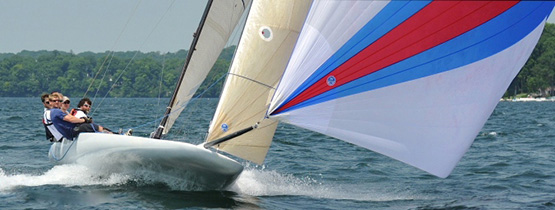
The inspiration for the Fireball design more than fifty years ago came partially from the classic scows of the lakes of mid-western America. This is a Melges Class A Scow.
As this Tramyard crowd have been regularly together for so long, they have not noticed the effects of the passing of the years on each other. So when Derek Jago got to reflecting among them last Autumn that maybe their best sailing years were spent in the Fireball Class, and that it was amazing to think it had been around for fifty years, former Fireball champion Brian Craig immediately suggested that if Derek would organise a post-50th Anniversary Reunion of the Irish Fireball Class past and present, then he – Brian - would see about making the Royal St George Yacht Club available as the venue, for after all it was the George – home club for most of them - which had the biggest Fireball fleet in the great days of the class’s Irish glory.
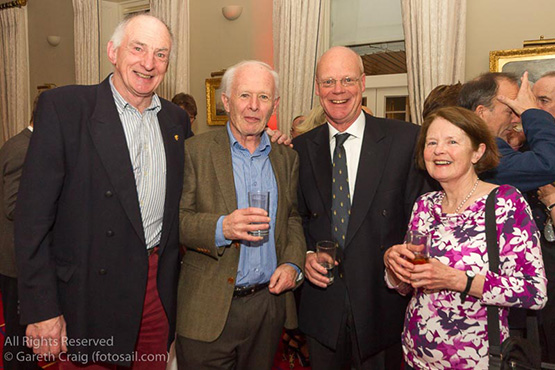
The party happens – Derek Jago (left) with former Fireballers Howard Knott, Peter Stapleton and Hilary Knott. Photo: Fotosail
Of course, when you do organise something like this, you will know what your own close circle of old friends now look like. But it’s a fascinating exercise in the observation of the aging process to wheel in people you mightn’t have seen in thirty and more years.
In fact, it might have been fraught with a certain risk of non-recognition of faces from the distant past. But the Irish Fireball Class was not only an outstanding success in its peak years, it went on to send out rising stars who were to make their mark in many other areas of sailing. Consequently last Saturday night proved to be a gathering of familiar faces of whom, in some cases, folk were saying: “But I never knew you were ever a Fireball sailor”.
Yet not only were they Fireball sailors once upon a time, but they were very proud of the fact. For in the nicest possible way, the Fireball was and is a bit of a cult thing. She was designed by Peter Milne, who at the time of her creation was working on the drawings for the latest Donald Campbell world water speed record challenger. In the midst of such a hothouse of technology and massive expenditure, it seemed like a breath of fresh air to take a little time out to create a boat which reduced sailing to its absolute essentials, and he did it so well that Peter Milne thereafter never quite matched this one divine inspiration.
And it was truly inspirational. After all, who would have thought that a minimalist boat, with just about zero freeboard and skinny with it, and with her slim hull further reduced in volume by having a cut-off pram bow, who could have thought it would be such a superb sailing machine when she’d a crew who gave total commitment to the concept and realized that the use of the trapeze was what Fireball sailing was all about?

The first in Ireland –Roy Dickson’s No 38 making a tentative visit to Dun Laoghaire in September 1962.
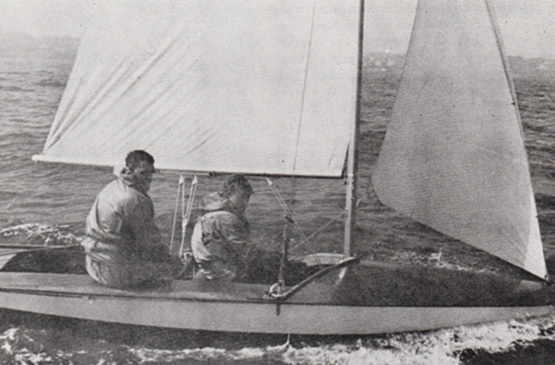
Champions – Roy Dickson crewed by David Lovegrove after successfully defending the Fireball Nationals in 1966.
Well, the first in Ireland was Roy Dickson of Kilbarrack and Sutton on the north shores of Dublin Bay, a man who cannot contemplate any boat without thinking about ways of improving it. He’d already been taking several sails on the wild side by building a Jack Holt-designed 16ft Hornet with a sliding seat in the manner of Uffa Fox’s famous sailing canoes, so when the design of the Fireball first appeared in Yachts & Yachting magazine in 1962, it was a eureka moment.
Roy’s first Fireball, no 38, made a tentative appearance across Dublin Bay in Dun Laoghaire at the end of the 1962 season, and next Spring it was revealed that other sailors from the north shore were following in his footsteps. They’d already set up a class association with Peter O’Brien as Chairman and Eddie Kay as Honorary Secretary, and it was expected that up to 20 Fireballs would be racing in Ireland by the end of the 1963 summer.
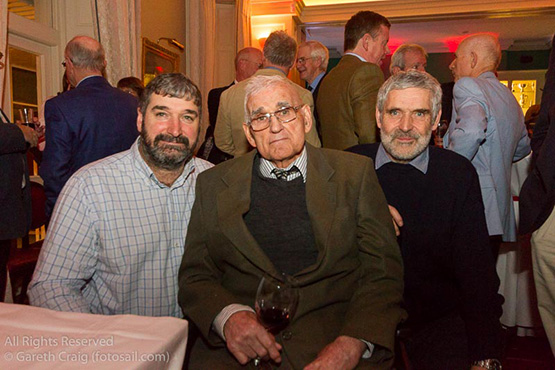
The founding father – Roy Dickson with his sons Ian (left) and David on Saturday night at the celebration of the Irish Fireball Class. Photo: Fotosail
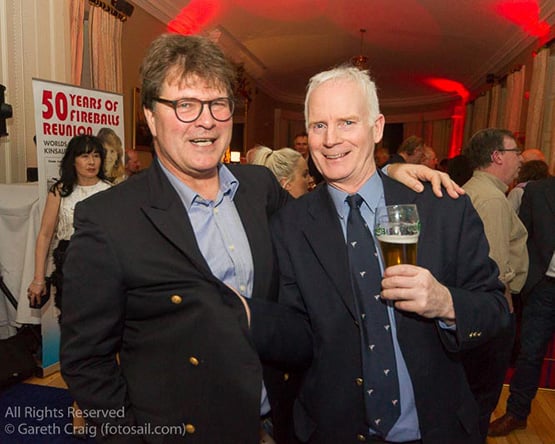
Jan van der Puil (left) with 1995 World Champion John Lavery. Photo: Fotosail

Early days – at an IYA Easter Meeting in Wexford the new Fireballs cut a dash by comparison with the older IDRA 14 and Enterprise in the background. Photo: W M Nixon
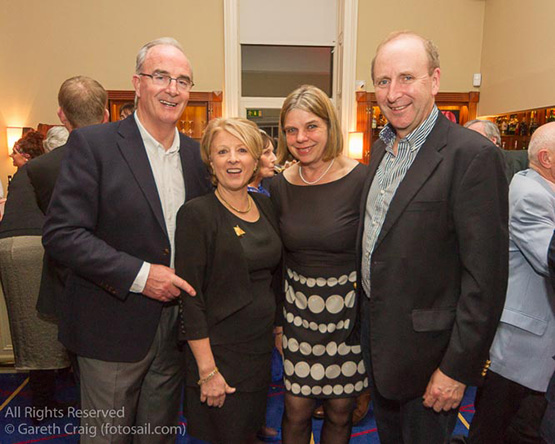
Celebrating the Fireball – Anthony and Sally O’Leary, with Cathy McAleavey and Con Murphy. Photo: Fotosail
It was an extraordinary breakthrough, the memory of it all made even more vibrant by the fact that Roy Dickson himself was there in Dun Laoghaire last Saturday night, his innovative Fireball years recalled as just another chapter in his own fantastic sailing career, which has gone right to the top both inshore and offshore.
The Fireball spoke eloquently to several successive waves of Irish sailors, and in the period between the mid 1960s and the late 1990s, you’d be hard put to say just what was the key year, with an early dose of extreme excitement being the Fireball Worlds at Fenit on Tralee Bay in 1970, John Caig from England being the winner. For although an unmatched high was reached in 1995 when John Lavery and David O’Brien of the National YC won both the Europeans and the Worlds in a mega regatta staged by their home club on Dublin Bay, at other times Adrian and Maeve Bell from the north – they were with Lough Neagh SC at the time - were very much in the international frame, counting many major titles.

Fireballs on an early outing to Sligo, where the Worlds were staged in 2011.
As for staging Fireball World Championships, Ireland has stepped up to the plate four times, with a particularly epic Worlds in Kinsale in 1977 where the Godkin brothers set the pace in the local fleet. Then there was the glorious home win at Dun Laoghaire in 1995. And the most recent Worlds in Ireland were at Sligo in 2011, where the great Gus Henry may have been best known as a stalwart of the GP 14 Class, but he too is a top sailor who savoured the Fireball experience.
At the height of the class’s popularity, nearly three quarters of the boats in Ireland were said to be an own-build, and Roy Dickson was the pace-setter in innovation. It’s said that if Roy turned up at a major international regatta with some completely new but barely perceptible additional feature on his boat, by the next championship you could be reasonably sure that at least half the fleet would have copied him.
But for some years now the class has seen plastic boats in the ascendant, which restrains the innovators. And numbers in Ireland are admittedly no longer so spectacular, for in its top years the truly active Fireball fleet here numbered 70 boats, which for an out-and-out performance dinghy was quite something.

There’s still as little bulk to the boat as possible, but they’re now built in GRP, as seen here with Frank Miller's boat at the Volvo Dun Laoghaire Regatta. Photo: VDLR
Yet while the fleets are reduced, the memories if anything are stronger than ever. The photos reveal the calibre of the people who were and are involved in Fireball racing in Ireland – it’s a national Who’s Who of sport afloat. And if that weren’t enough, the roll call of those who preceded John Lavery and David O’Brien in the intense battles to win the World Championship is of truly global stature in international sailing.
The first one of all in 1966 was Bob Fisher, no less, crewed by Richard Beales. Then Steve Benjamin of the US was in fine form in the 1970s, as he won in ’76 and then defended successfully at Kinsale in 1977. But in 1978 at Pattaya in Thailand, a new name came centre stage – the one and only Lawrie Smith. Then in 1981 the Worlds winner was future top dinghy designer Phil Morrison, with Fireball mods and tuning worthy of Roy Dickson.
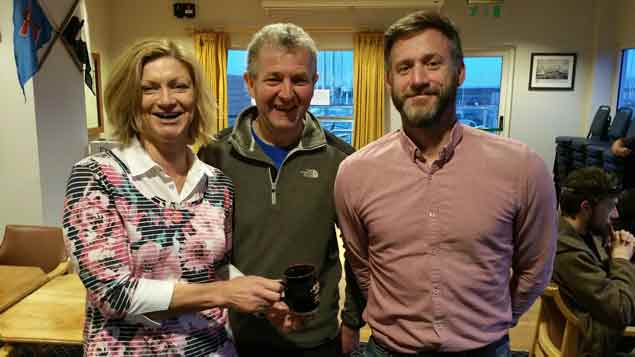
Current Irish Fireball Class Chairperson, seen speaking at last Saturday’s party, is Marie J Barry. Photo: Fotosail
In 1994 it was ace sailmaker and multi-champion Ian Pinnell who won the Fireball Worlds, and this set the bar high for John Lavery and David O’Brien in Dublin Bay in 1995. Faced with the challenge, they implemented a rigorous two-year training and competition programme in the countdown to the big one, and it all came out as planned.
As the Fireball Worlds 1995 were staged in September, the rest of the Irish sailing community were well home from holidays and back at the day job, so those driving home from work on the Friday night heard it on the car radio as one of the top stories on the evening sports news. Ireland had won a world title. Better still, it was in sailing too. And it was on the peaktime national news. It was a moment to be recalled and savoured many times in Dun Laoghaire last Saturday night.

We can always use a cover like this – welcome news with David O’Brien and John Lavery from the Sept/Oct 1995 Afloat.
See full Fireball 50th photo gallery by Gareth Craig of Fotosail here
Ireland’s Boats & People – How Do We Get Them Together?
The recently-published ISA Survey of Club Racing commissioned and supervised by Board Member Jack Roy has started the process of putting together a realistic picture of how we sail and go afloat for recreation, and it was analysed on publication here in Afloat.ie.
It’s logical to have made the beginning with club racing, as racing provides its own narrative and a straightforward set of entry numbers and results. But it will become more complex as the national authority tries to provide realistic figures for day sailing’s less competitive aspects. And of course, once we enter the world of cruising as defined by sailing and boating projects which include passage making, both coastal and offshore, together with overnight on-board stops, then it can become much more difficult to get meaningful data.
Yet with the ISA’s Cruising Conference for February 20th already booked out within a few days of being announced on Afloat.ie, clearly that is an area in search of services and support, a section of sailing which is difficult to quantify yet obviously of strong interest to a significant number of boat enthusiasts. W M Nixon takes a look at how the complexity of our sport’s many specialities makes it difficult to provide a clearcut picture for possible recruits to sailing.
Where would we be without the International Optimist Dinghy? The little solo-sailing boxes and their attendant support teams of mum and dad and the dog and the old 4X4 or station wagon or people carrier or whatever may seem to take up an awful lot of space and time, and all just so that one little person can go sailing.
But at least that one little person does go sailing. The ISA figures are brutally straightforward. In terms of genuine turnouts afloat at clubs throughout Ireland, in boat numbers the active Optimists are exceeded only by the Lasers, and this is arguably because Lasers aren’t age-limited, whereas the Optimists most definitely are.

Optimist airborne. This is Ireland's second most popular class
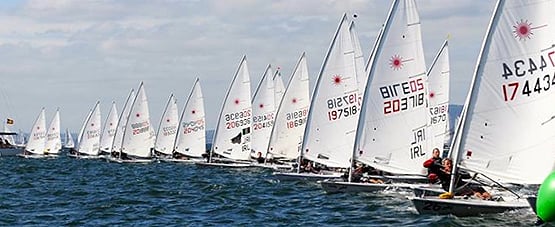
Ireland’s most popular dinghy class, the Laser is seen here at the Zhik Irish Nationals at Ballyholme
So we give a qualified cheer for the success of these two little boats. But it’s qualified because they’re single-handers which fail to provide any crew-relating sailing skills. Leading sailing figures as diverse as Des McWilliam of Crosshaven and Norman Lee of Greystones have been eloquent in promoting the notion that we should be doing more – much more – to encourage two-handed boats, and if we can persuade people into three-handed boats, well, so much the better.
Certainly that’s one of the reasons why our header photo says so much. A lone sailor in an Optimist or Laser promotes too much of a solitary, even an isolated image. And a two-handed boat like the GP 14, whose strong fleet figures in the ISA survey show the class’s vigour, is arguably just an act for a dynamic duo – it’s Strictly Come Dancing goes sailing…..
But getting three together to race a characterful boat like the National 18 with style – now that’s something special, that really is a superb combination of people skills interacting with sailing talent. And it’s a joy to behold. Yet anyone can see that for a complete beginner to sailing, this extraordinary silhouette of Tommy Dwyer’s National 18 against the November sky above the Hill of Howth will have an otherworldly air about it – “That’s not for me” is as likely a response as “Let’s have a go at that”.
Even those of us who have been in sailing for longer than we care to remember find the image decidedly thought-provoking, for we have some idea of what has been involved in creating the circumstances for this seemingly effortless balancing act, this lighter-than-air effect in the unlikely setting of a November afternoon.
Over the past year or so we have been recounting in Afloat,ie how the Cork Harbour National 18 Class, with very tangible backing from the Royal Cork Yacht Club, have been in the forefront of the development of the new ground-breaking Phil Morrison take on the long-established National 18, which is a developmental class which from time to time takes a leap in hull design, and moves forward in order to keep the spirit alive.
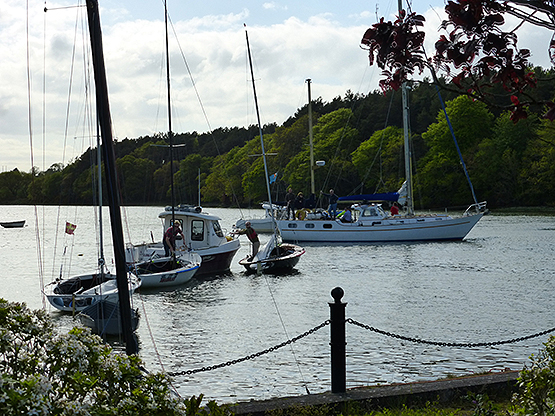
The National 18s are part of the fabric of Cork Harbour sailing. Before the new Morrison boats arrived in July, the old fleet were seen here in May 2015 after their annual race to Ballinacurra in northeast Cork Harbour in company with the Dwyer brothers’ cruising ketch. Photo: W M Nixon
Acceptance of this is something which seems to be bred into Cork’s National 18 enthusiasts, many of whom have the advantage of being firmly of the opinion that a proper dinghy needs three people to sail it. But the social matrix which has built up around Cork Harbour over many decades with this concept at its heart is not something which will necessarily travel easily to other areas, and although the six boats of the National 18 flotilla which visited Howth for the Open Day got a great reception and gave many people from other classes a marvellous time afloat, it’s probable that the very different mood around sailing in Dublin means that something so technically and socially challenging as a three man dinghy is a step too far.
Sailing in the greater Dublin area seems to exist within a framework of independent balloons. While there are those who will happily move from one boat type to another and cheerfully spread their talents and enjoyment about, by contrast there’s the Dublin Bay Sailing Club Thursday Evening Phenomenon.
Thursday is when the DBSC cruiser classes go out to race. And there’s an entire cohort of people, mostly folk who work in offices in the city, who on a Thursday evening go straight to Dun Laoghaire, get aboard a pontoon-based cruiser owned by someone else, go out and race in some very specific crewing job, then come back in and have supper in club or pub with their shipmates, and then that’s it until next Thursday. Just one evening each summer mid-week is their entire sailing programme. Weekends are for something else. And as for the hassle and mixed joys of boat ownership and maintenance, that’s not their department at all.
It’s a very metropolitan, very citified yet specialized way of doing things, and Dublin is one of the very few cities whose location facilitates it. It will be fascinating to measure it, for Dublin’s way of sailing is steeped in history and tradition. But for now it’s refreshing to look at a place which has had a sailing tradition in times past, but somehow lost it, yet it’s coming back again, and one of the good news stories towards the end of 2015 is that the new Youghal Sailing Club has been accepted into the ISA fold.
Youghal at present is a difficult place for sailing, as the tidal power of the mighty Munster Blackwater sweeps straight through the estuary and along the old town’s waterfront, and the creation of any meaningful modern facilities will have the immediate difficulty of silting by incredibly adhesive black mud.

With the sun out, and the tide in, Youghal looks to be an ideal location for the easy installation of a marina….....Photo: W M Nixon
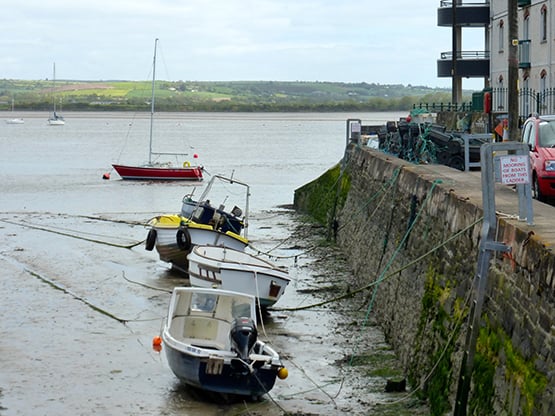
….but with the sun in and the tide out, the mud problem is revealed. Photo: W M Nixon
Thus, as dedicated Afloat.ie readers will have recently observed, no sooner had one group announced that a marina in Youghal was on the way than another longer-established group quietly suppressed the story, as they’re well aware of the engineering and dredging difficulties involved, and premature announcements will only slow any project in the long run.
In the fullness of time, a marina at Youghal will be a godsend for any cruiser plugging along the south coast. It’s not always the easiest coast in the world to make a passage along, sometimes it can seem an awfully long way to Cork from Dunmore East or Kilmore Quay even if you do make stopovers at Dungarvan or Helvick, and there are times when the hardiest seafarer is glad enough to get his boat secured to a good big pontoon.
But that’s for the future. Meantime, the locally-based keelboats are using either the restless anchorage off the town, or the more serene pool across the estuary at Ferry Point on the east shore, while the new club’s flotilla of GP 14s are stored in spare warehouse space during non-sailing time, and when they do go sailing it turns out their clubhouse is a moveable feast - it’s a caravan which can be towed to a choice of sailing locations.
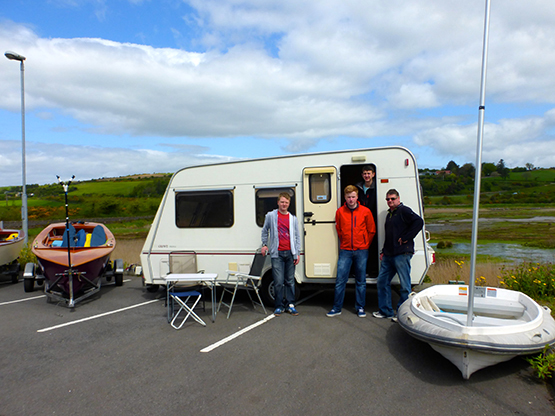
A moveable feast. Members of the newly-affiliated Youghal Sailing Club with their caravan HQ, Adrian Lee in doorway. Photo: W M Nixon
On the national stage, it is young Youghal GP 14 sailor Adrian Lee who has been among those flying the club’s flag, and there’s hope in the air. When we were there in May on a fine day that promised a summer which never arrived, we couldn’t help but think that when they do get their facilities and maybe even a clubhouse, they’ll look back to the days of the caravan and ad hoc racing arrangements with sweet nostalgia. For sometimes, it’s much better to be travelling than it is to arrive.
But for the rest of us, the message from Youghal is simple. The sea is for sailing. Use it or lose it. By all means get proper people surveys done which indicate the way numbers are shaping up and things are going. But really, if you want to persuade people to go sailing, the best way is by example, getting afloat as much as possible yourself. And maybe then you’ll find the time to welcome aboard newcomers too.

Reviving Youghal sailing – on race days, the club’s caravan is simply towed down to the pier and the races are started from there. Photo: W M Nixon
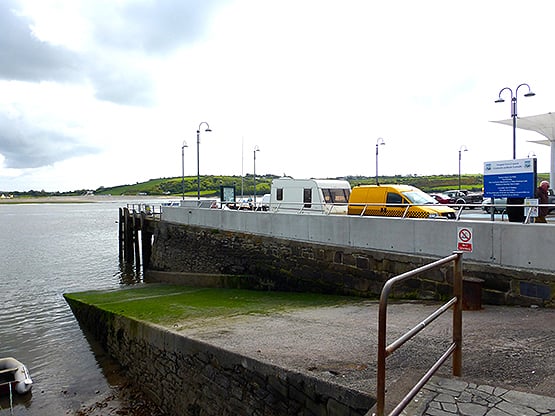
Youghal’s massive public slip provides launching for the YSC sailing dinghies, but during 2015 the boats had to be stored at the other end of town when not in use. Photo: W M Nixon
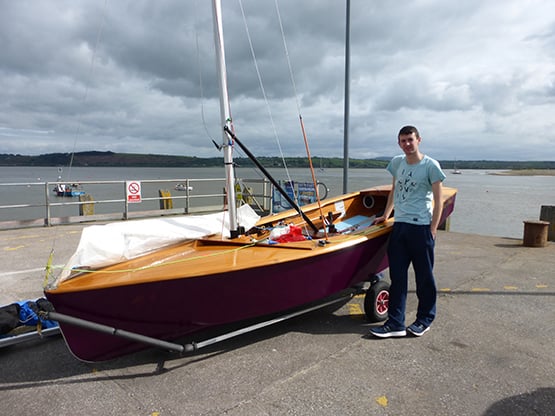
The pace-setter. Adrian Lee of Youghal SC with his Duffin-built GP14. Photo: W M Nixon
Click to download: ISA Survey of Club Racing
Bad Weather Is Good Weather For Ireland’s 2015 Sailing Season
Anyone with whatever you like in the way of a boat and a selection of sundry sails to power her along can have a season of pleasant memories - provided there’s a summer of reliably good weather. It takes an atrocious summer to prove the real mettle of a sailing and boating community. W M Nixon reckons Ireland had a great sailing year in 2015 despite the weather, and he takes an enthusiastic canter around its more outstanding events.
Is a summer of settled weather really what we need for the classic Irish sailing season? The classic Irish sailing season is a unique creature. For although we stage more than our fair share of major events with an increasing tendency to settle on the four day regatta format as being the ideal, the underlying backbone of our sport continues to be club racing, midweek and weekend alike.
Evening and weekend racing went through something of a dip in the boom years as people became bedazzled by the attractions of the big regatta shows, pouring their resources and energy into seeing and being seen in glamour events at key venues.
Yet after a while, you begin to get the notion that if absolutely everyone wants to be there and is there, then what’s the point? So maybe record turnouts had ceased to be fashionable in any case. But as it is, the onset of the austerity years meant that those who managed to continue to sail at all (for inevitably many took time out from our sometimes expensive vehicle sport) found that what was being provided on their own doorstep was the best value for money.
In this new cherishing of the local, once again we were reminded of how utterly dependent we are on something over which we have no control whatsoever. The weather. And within the big weather picture, the most important single factor is the wind. And the fact is, in a summer of good and settled weather, the time for evening racing is also the time of day which is least likely to have any wind at all.
So although fair-weather sailors may remember the weather of 2015 as something which is better forgotten altogether – a fact reinforced by some of the year’s worst conditions being in the peak sailing months – the reality is that most club Sailing Secretaries have happily been able to report a good season for regular club home events, with a high proportion of races completed.
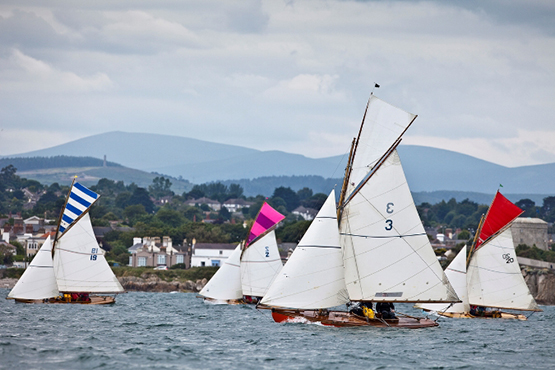
Cherishing the local while spreading the wings a bit – the 118-year-old Howth 17s ventured across Dublin Bay for the Volvo Dun Laoghaire Regatta. Photo: VDLR
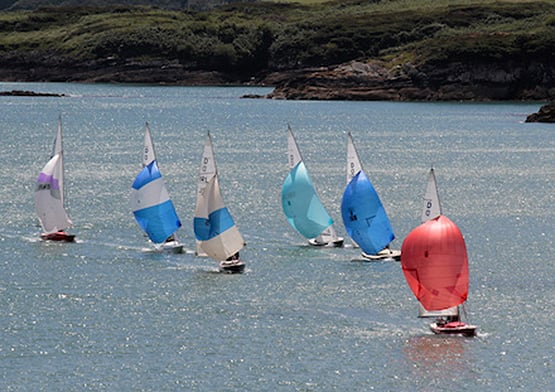
Cherishing the local while staying local – the mostly veteran International Dragons in Glandore have had a good year. Photo: Kathleen Hayes
All too often in a good summer, as boats crawl across the evening finishing line on a shortened course in the faintest of zephyrs, you’ll hear the slightly apologetic mantra: “Well, we got a result”. But how much better it is that crews should arrive back into the clubhouse with the full course sailed, great sport enjoyed, and the exuberant mood of an evening well spent afloat racing just as hard as you can against people who are your friends and neighbours ashore. And as for those who complain that it was too cold and too wet, you can always retort with the old Scandinavian wisdom: “There’s no such thing as bad weather. Just bad clothes….”
We certainly heard a lot of that old saying during 2015, yet any overview brings a cornucopia of spectacular sailing memories with sunshine somehow breaking through at every turn. If we had to pick four highlights in Ireland, they’d be the Dun Laoghaire to Dingle race on June 11th, the Sovereigns Cup/ICRA Nats at Kinsale from June 24th to 27th, the Volvo Dun Laoghaire Regatta on Dublin Bay from 9th to 12th July, and the Cork Dinghyfest 2015 at the Royal Cork in Crosshaven from August 20th to 23rd.

The wild and woolly west – racers in the WIORA Championship in Galway Bay took on everything the Atlantic could throw at them. Photo: Gareth Craig
Supporting those four pillar events are other popular happenings such as the WIORA Championship (a real cracker in 2015, staged on Galway Bay from Galway Port by Galway Bay SC), the much-loved West Cork regattas in their traditional time-frame of early August, sailed as a family-friendly four day event which nevertheless calls itself Calves Week, the time-honoured Regatta Weeks in the first half of August on the Shannon’s great lakes of Lough Ree and Lough Derg where Shannon One Designs set a stately pace for a fleet including visitors such as the increasingly vibrant Dublin Bay Water Wags (first established as a class in 1886), and the traditional and classic gatherings for the mostly gaff rigged craft in the Glandore Classics in July, preceded by the DBOGA’s Leinster Plate in Dublin Bay as May morphs into June, with the fleet returning to Poolbeg Y & BC in the heart of Ringsend where, in July, they could celebrate the re-birth of the famous John Kearney-designed Ringsend-built yawl Mavis at Camden in Maine.
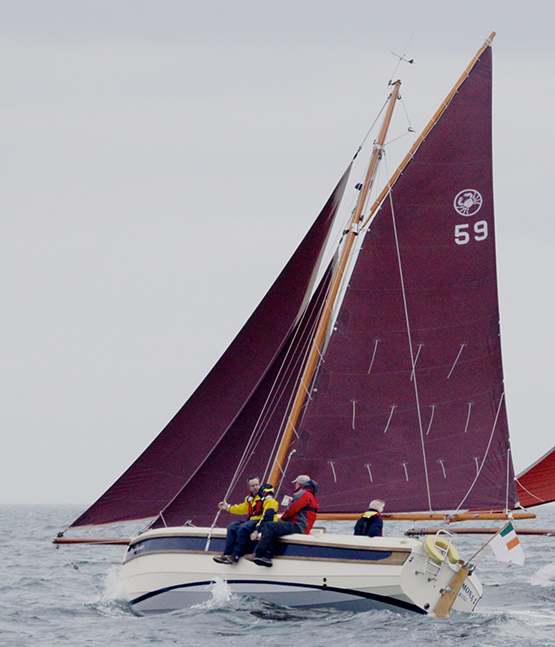
Dennis Aylmer’s Cornish Crabber Mona won the DBOGA Leinster Trophy. Photo: Dave Owens
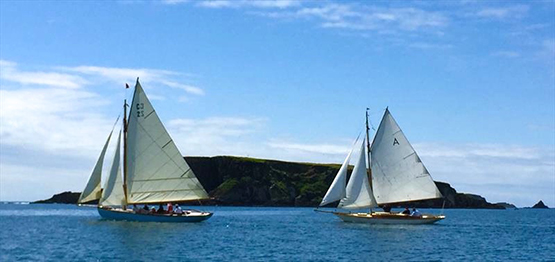
Cork Harbour OD Elsie (1896) and Victorian cutter Airlie find a bit of summer at the Glandore Classics.
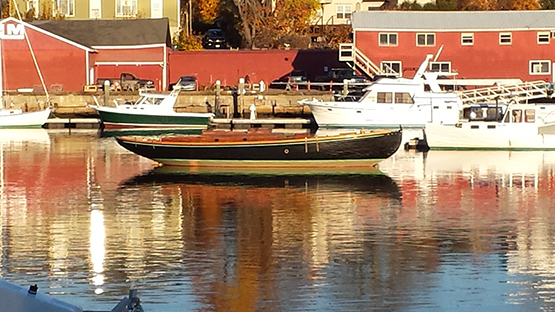
The historic Mavis newly restored - she will definitely look much better with full rig in place, but for now she greets the Fall in Camden, Maine. Photo: Denise Pukas
With events being successfully slipped in under the meteorological radar as Race Officers looked out for some hopeful evidence that a malevolent weather front would soon be followed by a benign weather back, inevitably some happenings failed to make the cut. The biggest cancellation was Howth YC’s time-honoured Lambay Race on June 6th, when a dense southwesterly airflow gusting to 39 knots-plus would have made it irresponsible to start giving racing signals to an extremely diverse fleet which included some very elderly classics. But while visitors were disappointed, for the locals it was only a postponement, as they knew that, for them, the Lambay would be raced as part of some other event in the crowded HYC programme which, thanks to the annual Laser Frostbites, has been continuous since April 1974. And in due course the Howth classes did indeed contest their Lambay Races, and the HonSailSec could proudly announce: “We got a result”.
Meanwhile the frustrations of that big non-event on June 6th seemed to spur the reviving Howth fleet to greater effort, and they went on to make hay with the opposition in many classes at both the Sovereigns Cup/ICRA Nats in Kinsale in late June, and the big one, the Volvo Dun Laoghaire Regatta in July. And for those who sail on the south side of Dublin Bay, the expansion of local sailing horizons as Greystones Marina gets further into its stride is a wonder to behold. One of the most rapidly-growing events on the East Coast is Greystones Regatta at the end of August, which fits in with the late summer Bank Holiday Weekend in the UK, and can thus link in with cross-Channel events coming across from North Wales.

Boat of the year? George Sisk’s well-tested Farr 42 WOW was a star at both Kinsale and Dun Laoghaire, and was also in the frame in the Dun Laoghaire to Dingle race.
After the bumpy ride which it provided through the main summer months, while it might be over-stating it to say that the weather smiled throughout early Autumn, it certainly did everything it could to help weekend sailing events. The MSL Park Motors Autumn League at Howth had superb racing throughout six glorious Saturdays, and although the CH Marine Autumn League at Royal Cork had one or two days which were less than perfect, it ended on a high with perhaps the best day’s sailing of the year anywhere and at any time in Ireland, its special quality emphasized in retrospect by the fact that as we write this annual report in mid-November, the weather pattern has gone to pot with Winter Leagues so far blown out.
Off the island throughout 2015, we’d memorable results in the RORC Easter Challenge in the Solent in April, the British GP 14s in August, the Rolex Fastnet Race the same month, and the Rolex Middle Sea Race in October. As for the cruising front, it was here that prolonged periods of generally bad weather had the greatest ill effects, but nevertheless some fine voyages were completed, and the round Ireland cruise – always an attractive project in any year – was a real challenge completed by a variety of craft.
It was not to be a special year for new boats, with one outstanding exception. In one of the most remarkable examples of club, class, group and community effort, the completely new Phil Morrison-designed National 18 was finally brought to the water thanks mainly to the Cork Harbour division of the class, with very tangible financial support from the Royal Cork Yacht Club and energetic fund-raising by class members. They were the stars both of the British and Irish National 18 Championship at Crosshaven in July, and the Dinghyfest there in August.

Now that’s what we call an ensign…..The Colombian Tall Ship Guayas flies the flag on Belfast Lough in July
At the other end of the size scale, the Tall Ships came to Ireland in considerable strength to Belfast in July. At the time, their exuberant presence was a painful reminder that Ireland north and south is lacking in a proper sail training ship even though the gallant schooner Spirit of Oysterhaven does her best. But there’s no escaping the fact that Spirit is a large yacht rather than a ship in any traditional sense, so the work behind the scenes by Atlantic Youth Trust to provide a new 40 metre brigantine was of special interest. At the time of writing, the word is that AYT have got over the first hurdle by receiving a supportive Letter of Intent from the Irish Government which – in official circles – is considered significant, while in Northern Ireland the eventual implementation of the Stormont Agreement will open the way towards positive involvement with an all-Ireland sailing ship which will be much more than just a sail training vessel in the formerly-accepted style.
But that’s something for the future, meanwhile who were the top winners in 2015? On the international front, it was a decidedly mixed year for those who hope to represent Ireland in the Rio Olympics in August 2016, and as it’s all very much work in progress and will remain so until March 2016, we’ll move on to global events which provided winners whose results will stick.
In a very hairy Transatlantic Race in July, it was Carrickfergus navigator Ian Moore who called the shots to such good effect on the RP 63 Lucky that she won overall. We formerly knew Lucky as Loki which Gordon Maguire skippered to the overall win in the 2012 Rolex Sydney-Hobart Race. But she ceased to be Lucky after Moore moved aboard Bella Mente for Cowes Week, and in the Fastnet Race Lucky got hung up on the Shingles Bank shortly after the start (as many have done before), and there she stayed for hours.
In the Rolex Fastnet Race, first Irish boat to finish was Enda O’Coneen’s Open 60 Kilcullen, but the best-placed Irish was RORC Commodore Michael Boyd with the Grand Soleil 43 Quokka 8, while the most memorable result was by Ronan O Siochru of Irish Offshore Sailing in Dun Laoghaire who took his hard-worked Sunfast 37 round the course to such good effect that she was top-placed sailing school boat out of a class of 32 sailing school entries.
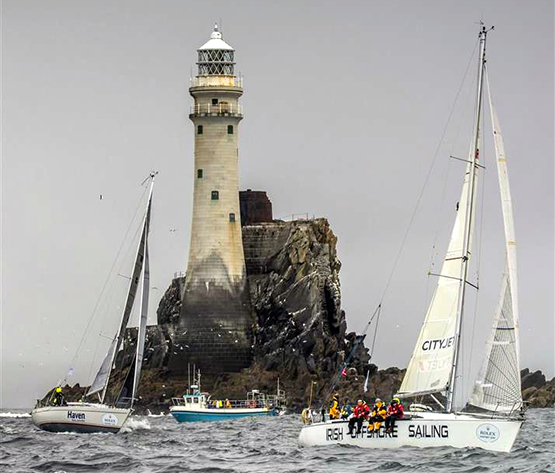
Ronan O Siochru and his Irish Offshore Sailing crew well on the way to winning the Sailing Schools’ trophy in the Rolex Fastnet Race 2015. Photo: Rolex
At the other end of the sailing experience spectrum, Dave Cullen of Howth took his classic Half Tonner Checkmate XV to the Worlds in Belgium with a crew of all the Irish talents, and won comprehensively.
Ian Moore then re-surfaced in October navigating aboard the Italian Cookson 50 Mascalone Latino in the 606-mile Rolex Middle Sea Race, and placed second overall to the TP 52 B2 (Michele Galli) by just seven seconds…….But even as everyone was still digesting this frustrating almost-made-it, there was good news for Ireland with Malahide YC father and son team of Dermot & Paddy Cronin winning the Double-Handed Division with their First 40.7 Encore with almost two hours to spare.
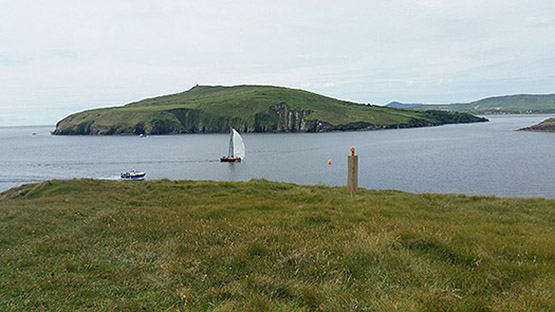
Antix takes second for line honours in the Dun Laoghaire to Dingle race
Nearer home, Anthony O’Leary of Cork was settling in with command of his new red Ker 40 Antix (formerly Catapult), getting off to a flying start with the Top Boat award in the Easter Regatta in the Solent. Then in the Dun Laoghaire to Dingle Race in June (enjoying a magic bubble of good weather in a mostly miserable month), it looked like Munster’s Antix might take the overall win at mid-race as she battled with Adrian Lee’s Cookson 50 Lee Overlay partners for line honours. But it was a race for J Boats of several sizes, with Liam Shanahan (NYC) and his family on the J/109 Ruth having their performance so sharpened by a couple of hundred miles of boat-for-boat racing against sister-ship Mojito that they won the Dingle dash by 22 minutes, and Antix found herself back in eighth. Ruth then went on to further glory offshore, and became the ISORA Champion 2015.
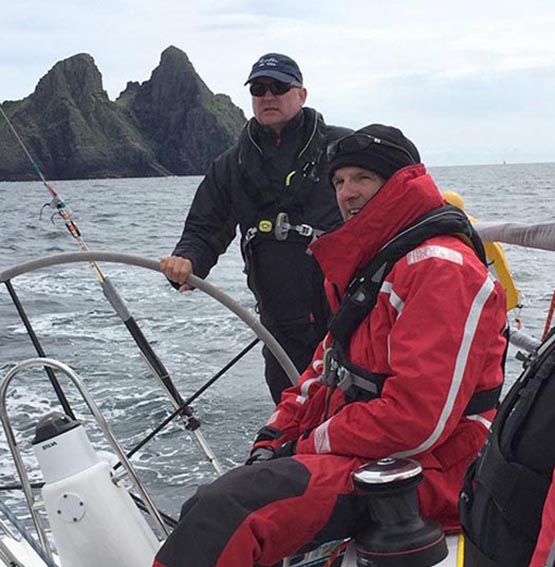
Liam Shanahan on the helm of Ruth with the Skellig astern and victory ahead in the Dingle race. He also became ISORA Champion 2015.
The two big four-day regattas at Kinsale and then Dun Laoghaire were mirror images of each other, in that Kinsale started light and finished good and fresh, while Dun Laoghaire started with stacks of breeze and a dismasting or three, but then finished light. Either way, it was great sport, and veteran skipper George Sisk revelled in it all by winning his class in both events with his Farr 42 WOW, and in Dun Laoghaire he did so with such style he was also Boat of the Regatta.
Other winners in Kinsale included John Maybury’s J/109 Joker from Dun Laoghaire, Ross McDonald’s X332 Equinox from Howth, the Corby 25 Fusion (Richard Colwell & Ronan Cobbe) also from Howth, and the Howth Under 25 J24 helmed by Cillian Dickson.
While Kinsale had been strictly cruiser-racers, the huge 420 boats-plus Volvo Dun Laoghaire Regatta was variety gone mad, with a historic visit for her first race in Dublin Bay in 45 years by the restored Flying Thirty Huff of Arklow (Andrew Thornhill) at one end, right down to GP 14s having their Leinster Championship and Water Wags doing their thing at the other.
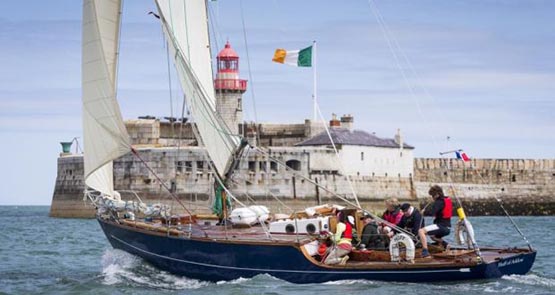
Huff of Arklow sailing again at Dun Laoghaire after 45 years away. Photo: VDLR
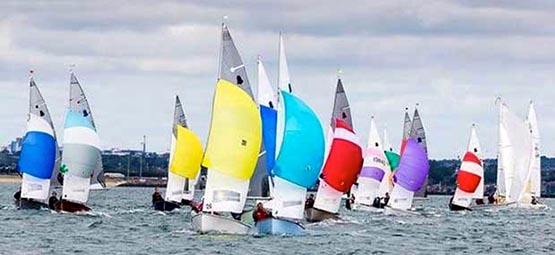
The GP 14s – racing their Leinster Championship – provided one of the most numerous classes at the Volvo Regatta in Dun Laoghaire. Photo: VDLR
At a time when the entire future of Dun Laoghaire Harbour is a matter of public debate with an intrusive cruise liner berth being proposed by commercial interests, Dun Laoghaire could not have chosen a better time to put on such a superb show of being Ireland’s premier leisure harbour, and it was arguably the best Volvo Dun Laoghaire Regatta ever since it was introduced in its contemporary form back in 2002.
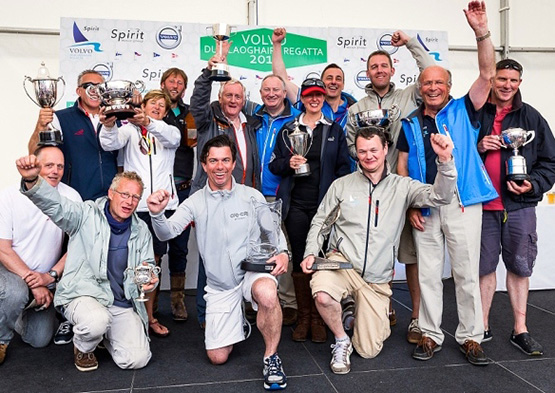 Round up the usual suspects….the prize winners at the Volvo Dun Laoghaire regatta. Photo: VDLR
Round up the usual suspects….the prize winners at the Volvo Dun Laoghaire regatta. Photo: VDLR

Now you see them……George Sisk and his crew of old (and not-so-old) mates. Photo: VDLR
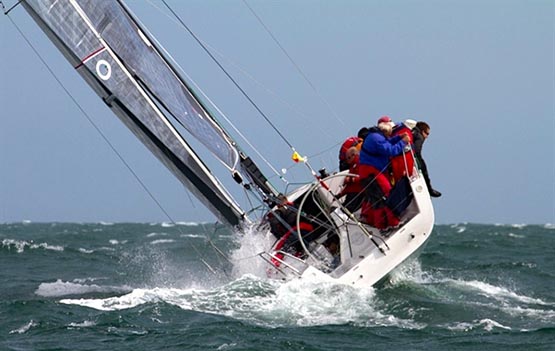
…..now you don’t (see them, that is). If anyone could tell us who or what this is on the breezy day at Dun Laoghaire, we’d be much obliged. Photo: Gareth Craig
With a total of 32 different sets of prizes to be given out at the end of the regatta, anyone who felt they knew what was really going on was clearly deluded, but out of it all there emerged the popular overall win over everyone by George Sisk and the golden oldies on WOW, and it was a victory cheered to the rafters.
In the dinghies, the new National 18s at Crosshaven at the end of July saw Tom Dwyer (RCYC) win his tenth Cock o’ the North trophy, an unprecedented record, and then in the British GP 14 Opens in August in Devon, Shane McCarthy & Andy Thompson of Greystones put it neatly away to bring home the title.
 Creating a buzz – the advent of the new Phil Morrison National 18s in Cork Harbour was the result of remarkable class, club and community effort. Photo: Robert Bateman
Creating a buzz – the advent of the new Phil Morrison National 18s in Cork Harbour was the result of remarkable class, club and community effort. Photo: Robert Bateman
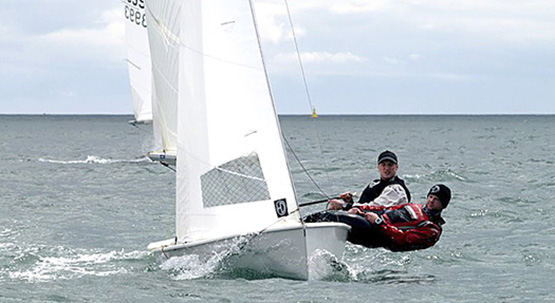
Shane McCarthy & Andy Thompson of Greystones were the international pace-setters in the GP 14s.
The Dinghyfest at Crosshaven in late August lived up to its billings and then some, winners including Jack Ryan & Ben Graf (Lough Ree, Mirrors), Geoff Power (Dunmore East, Toppers), Paul McMahon & Laura Houlihan (Howth, RS400), Marty OLeary & Rachel Williamson (RStGYC, RS 200), Dara Donnelly & Cliona Coyle (NYC, RS Feva), Douglas Elmes & Colin O’Sullivan (Howth, 420), and Tommy Dwyer & Willie Healy (Cork, National 18).
The dinghy brigade were also well represented in the cruising stakes, as a remarkable round Ireland voyage by the Ogden brothers of Baltimore SC in their Drascombe Lugger showed what could be done by grit and sheer determination even in one of the worst summers ever experienced for round Ireland cruising.
And finally, the traditional season came to its close with the All-Ireland Helmsman’s Championship raced in the first weekend of October in the SailFleet J/80s at the National Yacht Club under the masterful direction of Race Officer Jack Roy. By that time in the season, even the keenest Corinthian sailors are beginning to feel a little jaded, so they need a crisply run event. With the weather obliging with an increasing sou’easter as the weekend progressed, Jack Roy did the business from the Committee Boat. And out on the racecourse, defending champion Anthony O’Leary of Cork - crewed by Dan O’Grady of Howth and Cian Guilfoyle of Dun Laoghaire - did the business big time too, providing one of the most convincing wins seen in the All Ireland for several years.
 The main man….Anthony O’Leary retained the All Ireland Title in convincing style. Photo: David O’Brien
The main man….Anthony O’Leary retained the All Ireland Title in convincing style. Photo: David O’Brien
Ireland’s Individuality In Boats Is Our Answer To The World’s Uniformity
Located on the fringes of Europe and set in challenging seas, Ireland does not offer an ideal setup for large-output series-production of recreational boats. We lack the economies of scale which are conferred on giant production companies in the crowded heartlands of Europe. There, the ready potential of a vibrant and easily-accessed market is allied with the availability of skilled workforces which are prepared to undertake the tasks in regimented and regulated settings. While these modern production plants may provide bright and well-ventilated conditions, nevertheless they’re markedly industrial in tone and style, and maybe not really in tune with much of life in our own highly individualistic island. W M Nixon takes a look at some of the stories of boat-building in Ireland, and reckons from current experience that specialized work is what we do best.
Despite the less-than-ideal conditions, over the years enthusiasts have given the Irish production fiberglass boat-building challenge their best shots. The continuing and much-enjoyed presence of boats of the Shipman 28 class at many of our sailing centres is a reminder that once upon a time, from the 1970s onwards in Limerick, there was a company called Fibreman Marine, later Fastnet Marine, which built the Swedish-designed Shipman 28 and then expanded the range to include the Fastnet 24, designed by Finot of France.
At much the same time, the Brown brothers were building the Ruffian range – of which the most popular was the Ruffian 23 – in their home town of Portaferry on Strangford Lough, while across the Lough at Killyleagh, Chris Boyd – who’d actually built the first Puppeteer 22s in Larne – set up shop a couple of years later in a new mini-factory and Puppeteers of several sizes rolled off the line.
Meanwhile on the shores of Cork Harbour, a popular range of variations on the Ron Holland Shamrock Half Ton design kept a harbour-side production plant busy for some years. And out west in Tralee, O’Sullivans Marine found themselves some decades ago in the forefront of design development with a new GRP National 18 built around the enthusiasm of the Cork Harbour fleet, and then they went on to build large numbers of the Tony Castro-designed 1720 Sportsboat. But having started as builders of smaller craft with a useful range of elegant lakeboats, they find that the lakeboat is what keeps them going today – it’s a case of going with the knitting while keeping well clear of more high-powered production temptations.
Other pioneers in Irish series boat-building have stayed in the marine business, but have moved their focus. How many know now that our very own marine conglomerate, BJ Marine with its wide boat-oriented interests at home and abroad, started life as a boat-building company with a range of van de Stadt GRP hulls, and then continued as the builder of the Ruffian 23?
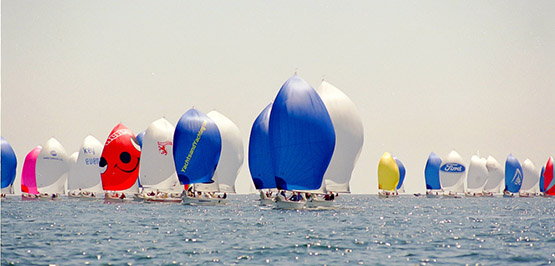 God be with the days…..seventy Tralee-built 1720s racing at Cork Week 2000, with Mark Mansfield the winner and Anthony O’Leary second. Photo: Robert Bateman
God be with the days…..seventy Tralee-built 1720s racing at Cork Week 2000, with Mark Mansfield the winner and Anthony O’Leary second. Photo: Robert Bateman
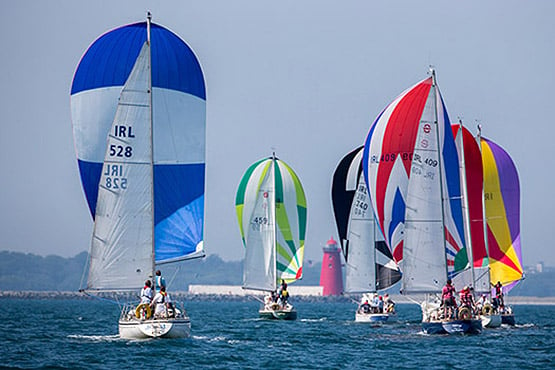 Shipman 28s racing in Dublin Bay. They were built in Limerick in one of several factories in Europe which between them produced 1300 of these boats. Photo: Courtesy VDLR
Shipman 28s racing in Dublin Bay. They were built in Limerick in one of several factories in Europe which between them produced 1300 of these boats. Photo: Courtesy VDLR

Ruffian 23s in Dun Laoghaire Harbour. Originally built in Portaferry to be a Belfast Lough class, at their height they were raced at about ten centres including Hong Kong, but now their most resilient strongholds are Dun Laoghaire and Carrickfergus.
Indeed the story of BJ Marine is in many ways the story of the Irish marine industry, for as the late Dickie Brown of Ruffian fame said of the glory days of their little firm of Weatherly Yachts: “We were the right people in the right place at the right time in the rapidly developing international marine industry. But later, there was no way a little local firm could hope to compete with the giants of the industry in the production of what was, in effect, the sailing equivalent of the small family car.”
It wasn’t just on the coast that semi-production boatbuilders were thriving - or at least surviving - at this particular stage of the Irish marine industry’s development. On the inland waterways, particularly around Carrick-on-Shannon there were firms of all sorts, mainly building motor-cruisers, but as well the great pioneer, O’Brien Kennedy, having come home to build Shannon cruisers, then returned to his first love of sailing boats and created the Kerry 6-tonner, characterfully built in GRP of simulated clinker construction, and still much-loved even if Kennedy International Boats is a long-gone memory.
But since the heady days of the 1970s, ’80s and ’90s, several economic storms and revolutions in production methods and materials have blown away much of the Irish marine manufacturing and boat-building industry. The crazy years of the Celtic Tiger only emphasized its demise, as the great waves of new boats joining the Irish fleet were almost entirely imported, while the concurrent property boom meant that even the humblest waterfront boatyard provided other-use high-end development potential which so quickly pushed prices through the roof that anyone who wanted to work at or build boats had to think in terms of finding premises just about as far as they could be from desirable waterside facilities, for that was all that could be afforded.
And yet, some companies have come through. Red Bay Boats in County Antrim started in 1977 as builders of standard little angling craft, but they soon saw the potential of RIBs, and now they’re world leaders. Having introduced a completely new kind of fast powerboat day cruising with their impressive range of multi-function RIBs, they soon realized that today’s people in a hurry want a complete package. So in Cushendall, Red Bay Boats will provide shore storage for your boat when you’re not using it, yet when you carve out one of those short-break holidays which are the way we live today, they’ll have your boat ready and waiting for instant launching, and off you go for a high speed cruise among the Scottish Hebrides – they’ll even organise cruises-in-company.
Across Northern Ireland on Lough Erne, the Leonard family of Carrybridge have taken over Westwood Marine from its production facility in England, and since 2013 have been re-establishing the production line in ideal premises – a former aircraft hangar at the lakeside St Angelo Airport on the Enniskillen-Kesh road. Westwood’s designer is the versatile Andrew Wolstenholme, whose astonishing variety of craft includes the hefty steel 57ft cruising barge-style yacht Ida for Tom & Dee Bailey of Lough Derg. It was a designer-client relationship which was remarkably fruitful, as the only real stumbling block was Dee’s insistence that the boat include a really good full size hot press - it took some time for the very English designer to grasp that she meant an airing cupboard.

One example of Wolstenholme design – the 57ft barge yacht Ida (Tom & Dee Bailey) on Loug Derg. Photo: Noel Griffin
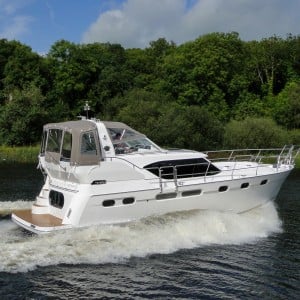
A very different example of Wolstenholme design – the Westwood A405 is now being built in Enniskillen.
For Westwood in their new Enniskillen base, Wolstenholme has been showing his skills in contemporary design with a complete revamp of materials used in the interior, but by any standards the Westwood A405 is a handsome modern craft, and anyone buying a new one from Enniskillen has the bonus of a year’s free berthing on Lough Erne.
Down at the other end of the country, adverse conditions is what keeps Safehaven Marine going strong. Everyone will be familiar with the dramatic videos of their pilot and patrol boats leaping abut like happy porpoises in the breaking water at the entrance to Cork Harbour when there’s a storm force southerly against the spring ebb. But by contrast, a visit to their production facility in Youghal is a soothing experience (once the enormous guard dog has accepted you’re a temporary part of the team), as it’s a sort of mini-cathedral of boat-building where craft capable of taking anything the sea can throw at them are built with meticulous attention in which the only noise comes when the vast extractor fans are activated. Building boats in modern plastics is inevitably a dusty business, and anyone who has worked at it will be fully appreciative of what Frank Kowalski has installed in Safehaven to keep the busy place dust-free.
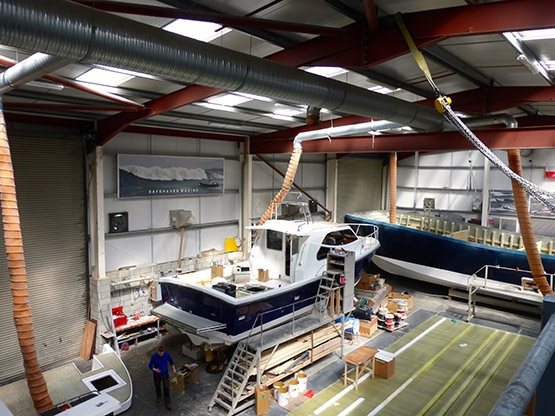
However, having a setup like this implies the building of high ticket boats in which expense is virtually no object if it can be guaranteed that they’ll fulfill their very special purposes. But for the vast majority of specialist boatbuilders – both professional, semi-professional, and amateur – it’s a case of making do as best you can, and often you’ll find rather special boat being built in unlikely places, often to the extent that the locals don’t known what’s going on, for in some cases they’ll barely know what a boat is in the first place.
From time to time we’ve given away snippets of information abut Jarlath Cunnane’s new 37ft alloy Atkins ketch which he has been building himself in a very hidden little shed beside a drainage canal on Clew Bay. Jarlath of course built the ice-voyaging Northabout - also in alloy - with Paddy Barry and circled the Arctic Circle with the project completed in 2005. But now that the likes of top Chinese skipper Guo Chuan are breezing their way through the Northeast passage in a giant trimaran in a fast sail of a couple of weeks, Jarlath has moved on. Northabout has been sold to be a expedition vessel in Antarctica (her last Irish port was Kilrush in May) – and the new schooner Island Princess is handling a treat, and moving at leisure among the islands of Connacht, while the hidden shed is given over to other business.

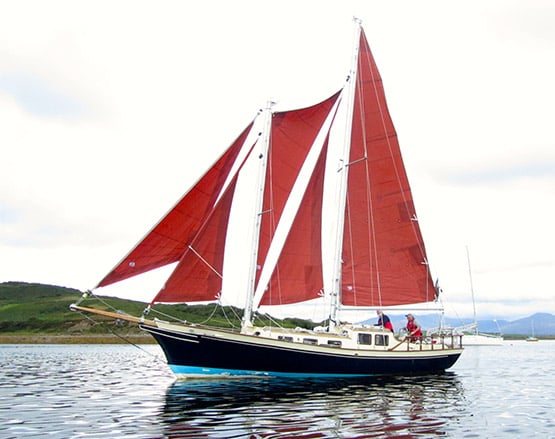 Jarlath Cunnane’s new Island Princess is just about as different as possible from his previous expedition boat Northabout except that she too is built in alloy.
Jarlath Cunnane’s new Island Princess is just about as different as possible from his previous expedition boat Northabout except that she too is built in alloy.
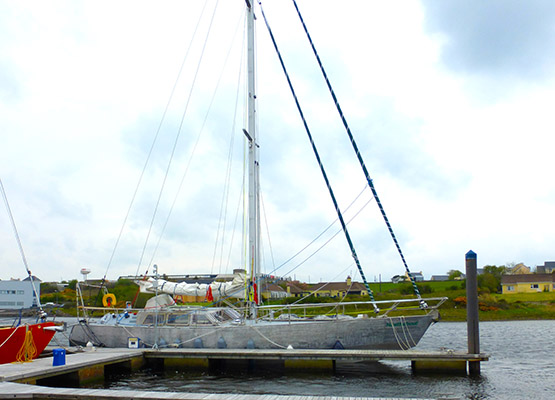
But deep in the heart of north county Cork, just about midway between Cork Harbour and Limerick, there’s a fine shed ready and waiting for the next bit of business. And the more unusual your requirements, the more interested Bill Trafford will be in doing it at Alchemy Marine, where he successfully completes boat projects which are so far off the wall that they’re over the hills and well into the next county.
Those of us who are into interesting boats will know that the most dangerous road in Ireland is the one from Carrigaline to Crosshaven, for the further along it you get, the more boats you will see moored in and around Drake’s Pool. They’re a briefly-glimpsed eclectic collection of boats of all ages, shapes and sizes, which means you’re constantly trying to see them while supposedly driving the car at the same time, which is not a good idea at all.
But back in August, the road along the north side of Crookhaven in far west Cork also became a Highway of Hazard. I always have a soft spot for any boats with the good sense to moor on the north side of Crookhaven, for although you’re not even half a mile from the much more fashionable and crowded anchorage off the village, you’re out of the tide. When the flood is making against a stonking westerly, the village anchorage is irritatingly uncomfortable, but a quick move, dropping the visitor’s mooring off the village, and then deploying our oversize windlass and ground tackle at the press of a button over to the north, and Bob’s you uncle, dinner can continue in total serenity.
So anyway one evening last August we were trundling eastward along the road looking favourably on the little group moored in towards Rock Island, and there among them was this heart-stoppingly beautiful little dark blue sloop which looked so much of a piece that I assumed she must be one of those incredibly pricey little semi-customised dayboats which top-end American builders up in Maine might occasionally produce at enormous expense, and even then only for very favoured customers.
Couldn’t have got it more wrong. Turns out she’s a completely re-booted Elizabethan 23 which Bill Trafford of Alchemy Marine up near Doneraile had been hoping to have re-crafted for a discerning owner from Crookhaven Harbour Sailing Club in time to make her debut at the Glandore Classics in July. But you can’t rush the final stages of a job like this for something so vulgar as a deadline, so Kioni quietly made her debut in West Cork in August, and she is simply amazing.
The Trafford speciality is seeing unexpected potential in glassfibre hulls of a certain age, for what he’s looking for is boats that look like yachts, with proper curved garboards and an encapsulated lead ballast keels. We now know that good glassfibre can last for ever, but in many cases the finish didn’t do justice to the superb materials in the original hull. But with more than a bit of tweaking, a beautiful butterfly can emerge from a very ordinary chrysalis.
Not that the Elizabethan 23 wasn’t something quite special in her day, which was 1969. Boatbuilder Peter Webster of Lymington was originally a baker in Yorshire, but he only wanted to builld boats, and he knew Lymington in Hampshire was the place to do it, and having a marina there – Lymington Yacht Haven – would provide the cash flow to support the boat-building. He started with the ground-breaking GRP Elizabethan 29 designed by Kim Holman, which set herself on the high road to success with major wins in Cowes Week and the Round the Island Race. But then Webster got some notions for a centreboard 23-footer, for which he sketched out rough drawings and then persuaded up-and-coming Welsh yacht designer David Thomas to put manners on them, with the result being the pretty-enough Elizabethan 23.
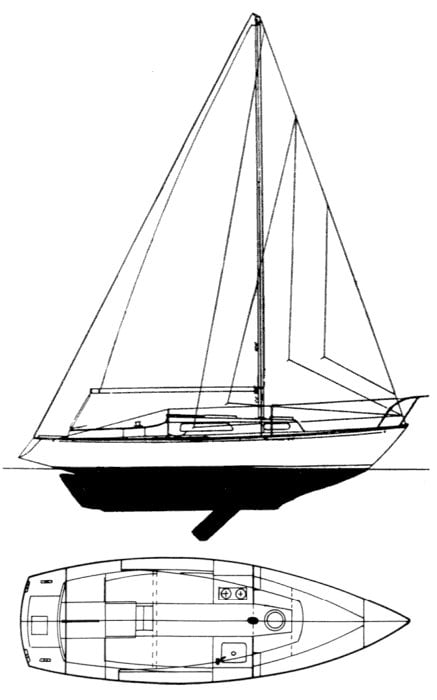 The original design for the Elizabethan 23 had this reasonably conservative coachroof…
The original design for the Elizabethan 23 had this reasonably conservative coachroof…
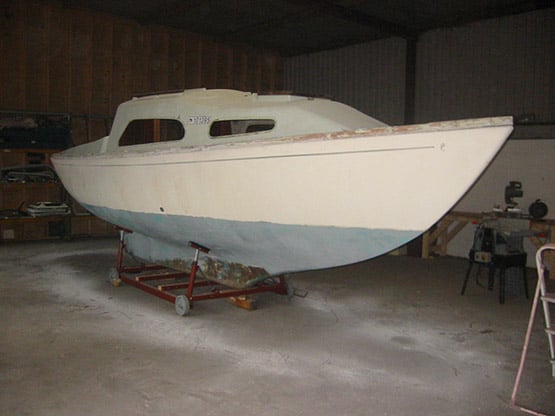
First big job is to remove deck and coachroof, revealing a rather nice hull underneath
The duo’s most successful combined effort was the Elizabethan 30, which did well in Half Ton racing and was a superb little cruiser-racer generally, so much so that Webster’s pet boat was the bright red Elizabethan 30 Liz of Lymington which he sailed to the end of his days, and then left in his will to David Thomas, who then did the same, and he died well advanced in years last winter.
But meanwhile the mouldings for the Elizabethan 23 had been taken over by another builder who reckoned the enlargement of the coachroof was the only way to go, and it was in one of these boats with its Acropolis on top that Bill Trafford saw the potential to provide a sweet little 26ft day-boat, though with a couple of bunks, a proper sea toilet, and an inboard diesel, for the clear-headed Crookhaven Harbour sailor.
They defined lines of negotiation between what Bill wanted to do, and what the owner required, and work proceeded apace. The photos says it all. Kioni speaks for herself. And there is no doubt but that Bill Trafford’s eye for what a proper yacht should look like is world-class-plus.
Perhaps the most crucial job of all – getting the counter extension just right. Bill Trafford hit the target perfectly.
Bill Trafford’s eye for a boat is well matched by his skill in working with wood – we can see only one glaring design fault in this photo in the workshop as Kioni take shape in her new form.
The skill in getting the counter extension just precisely right sets the tone of the entire project. And as for the quality of the workmanship in wood – that’s truly a wonder to behold. But what’s this about a design fault in that nearest photo above? Not to worry – it’s not in the boat. It’s to do with the door to the workshop lavatory.
That great boat designer and builder Uffa Fox says in one of his books that whether it’s the privy in the garden, or the lavatory in the boatbuilding shed or wherever, then the door to the lavatory should always open inwards. Thus if you’re taking your proper leisure therein, and seated comfortably and wish to contemplate some good work whether it be in the garden or on the boat under construction in the workshop, then if you’re on your own you can leave the door open the better to appreciate your work. But if someone arrives unexpectedly, you can kick it shut without a bother…….
Although Kioni makes a feature of beautifully finished timberwork, it’s not excessive. The really skilled boat creator knows that less is more, and a discreet yet effective little toe rail is much more pleasing to the eye than some hulking great heavy bit of bulwark or beading.
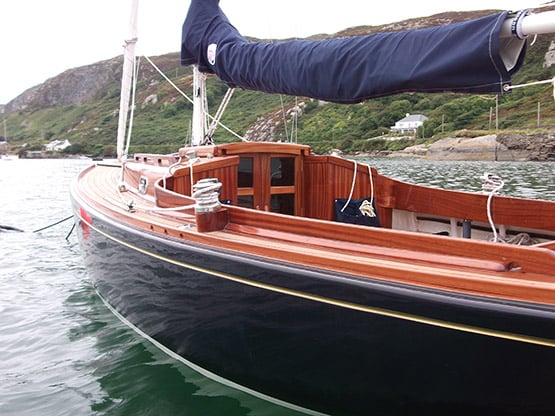
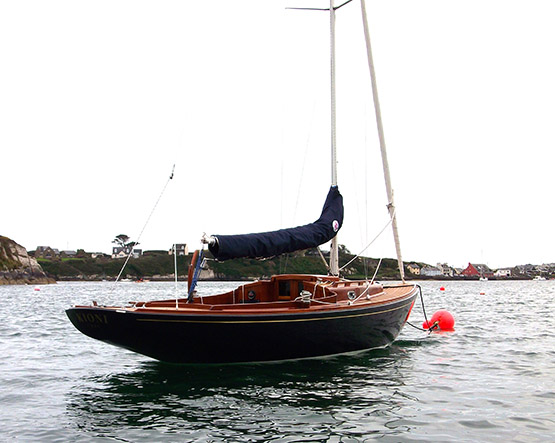
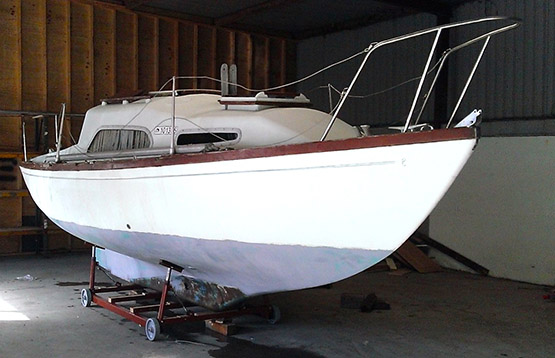
……came from this
So now you know the style of Bill Trafford’s work, and if you’re interested, his workshop is 70ft X 45ft with a door 15ft wide and 14ft high. He reckons he could do two Kionis a year. But be warned. He always has some other ideas at the back of his mind. His real ambition is to buy a battered old GRP Nicholson 43, lengthen her stern out into something like a Fife counter, give her straight stem the tiniest hint of a clipper bow, stick on an 8ft bowsprit, and turn her into a re-born gaff schooner…………
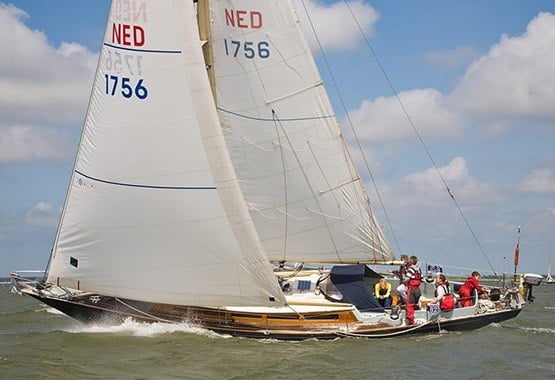 A standard Nich 43. Bill Trafford’s dream would be to turn her into a 47ft gaff schooner with a classic long Fife counter and a hint of a clipper bow
A standard Nich 43. Bill Trafford’s dream would be to turn her into a 47ft gaff schooner with a classic long Fife counter and a hint of a clipper bow




























